Venomous snakes are among the most fascinating and feared creatures in the animal kingdom. With over 600 species capable of injecting venom, these reptiles play a vital role in balancing ecosystems while captivating herpetologists and wildlife lovers alike. In this guide, we’ll explore 29 types of venomous snakes found across the world—learning how to identify them, where they live, and what makes their venom unique. Whether you’re a traveler, nature photographer, or curious learner, this article offers an in-depth yet beginner-friendly look at the planet’s most powerful serpents.
1. Inland Taipan (Oxyuranus microlepidotus)
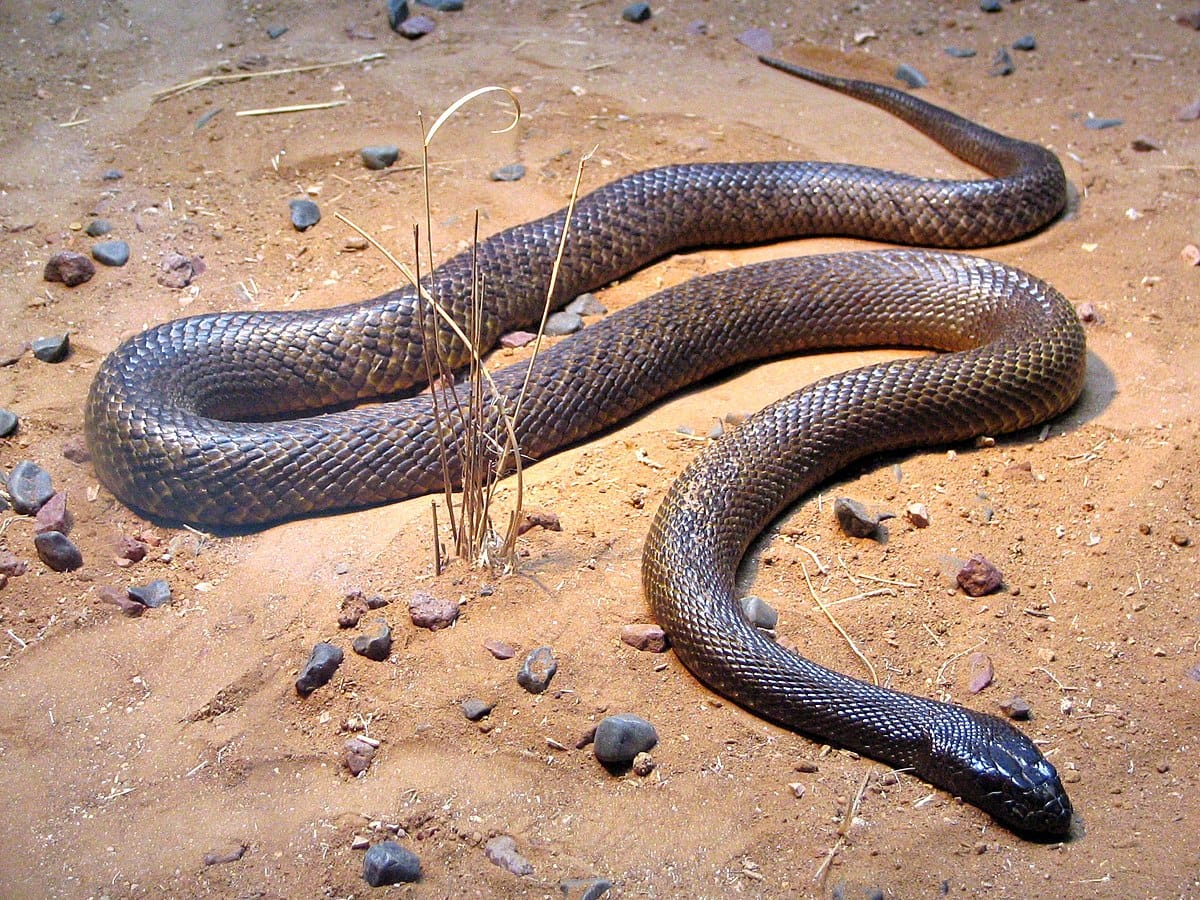
Known as the “fierce snake”, the Inland Taipan holds the title of the world’s most venomous snake. Native to the arid regions of central Australia, it produces venom so potent that a single bite can kill over 100 adult humans. Despite its terrifying reputation, the Inland Taipan is shy, reclusive, and rarely encountered in the wild.
Identification
This species has a slender body, averaging 1.8–2 meters (6–6.5 ft) in length. Its color changes seasonally—from dark brown in winter to light olive in summer—helping it blend with the outback terrain. The head is narrow, eyes small but sharp, and scales smooth with a subtle iridescent sheen.
Venom and Behavior
The Inland Taipan’s venom contains a lethal mix of neurotoxins, hemotoxins, and myotoxins, acting within minutes. It immobilizes prey almost instantly, primarily feeding on small mammals. Interestingly, this snake avoids confrontation and prefers to retreat rather than strike. Human fatalities are extremely rare due to its remote habitat and calm temperament.
Habitat and Range
It resides in clay plains and deep soil cracks across southwestern Queensland and northeastern South Australia. These environments provide ideal hiding spots from predators and extreme heat.
Fun Fact
Although the Inland Taipan has the world’s deadliest venom, it is considered one of the least aggressive snakes—a gentle giant of the desert.
2. King Cobra (Ophiophagus hannah)
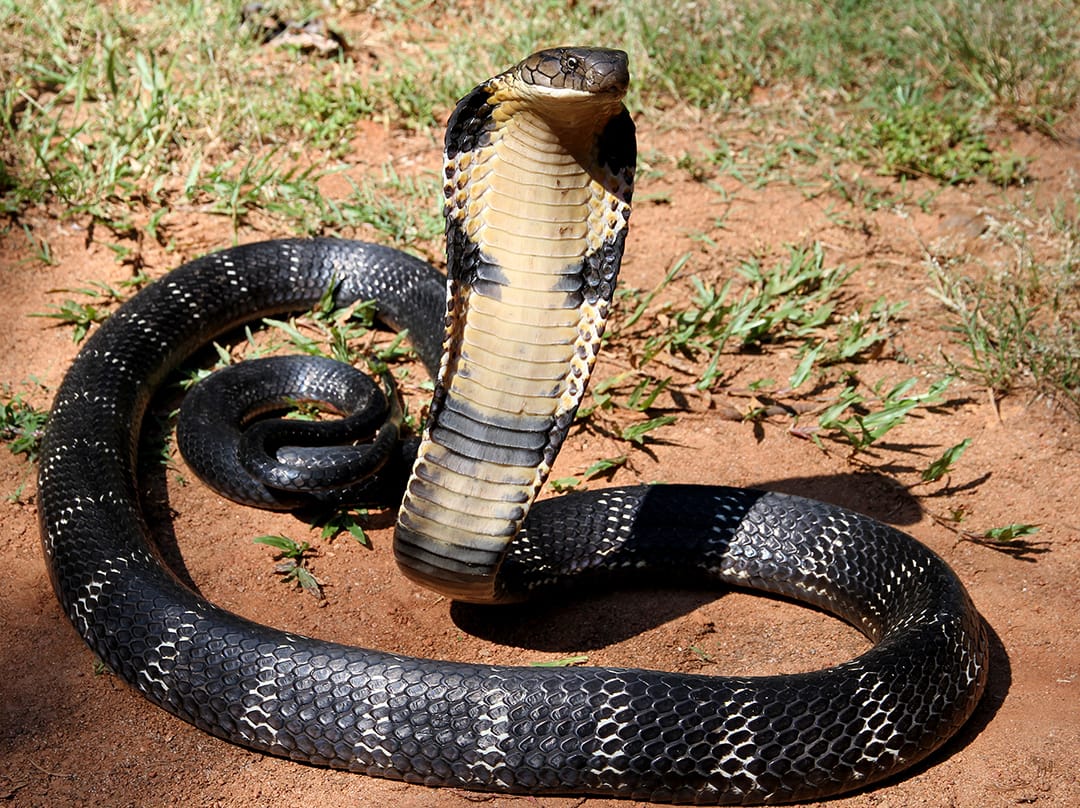
The King Cobra is the world’s longest venomous snake and an icon of Southeast Asian jungles. Revered and feared in equal measure, it embodies power and grace. Unlike most snakes that feed on rodents, the King Cobra specializes in eating other snakes—including venomous ones.
Identification
Adults can grow up to 5.5 meters (18 ft) long. They have smooth olive, brown, or black scales with pale bands and a broad, flattened head. The hood is narrower than that of typical cobras but expands impressively when threatened. Their large eyes and excellent vision allow them to detect movement from over 100 feet away.
Venom and Behavior
The King Cobra’s venom is primarily neurotoxic, targeting the nervous system and leading to paralysis. Though not as potent as that of the Inland Taipan, its large venom yield—up to 7 milliliters per bite—makes it extremely dangerous. The species is intelligent and territorial, known to stand its ground and even raise one-third of its body when threatened.
Habitat and Range
Found across India, China, and Southeast Asia, the King Cobra thrives in forests, bamboo thickets, and near rivers. It’s one of the few snakes that builds a nest for its eggs, guarding them until they hatch—an extraordinary display of parental care.
Fun Fact
The King Cobra’s scientific name, Ophiophagus hannah, literally means “snake-eater,” perfectly describing its diet and hunting behavior.
3. Black Mamba (Dendroaspis polylepis)
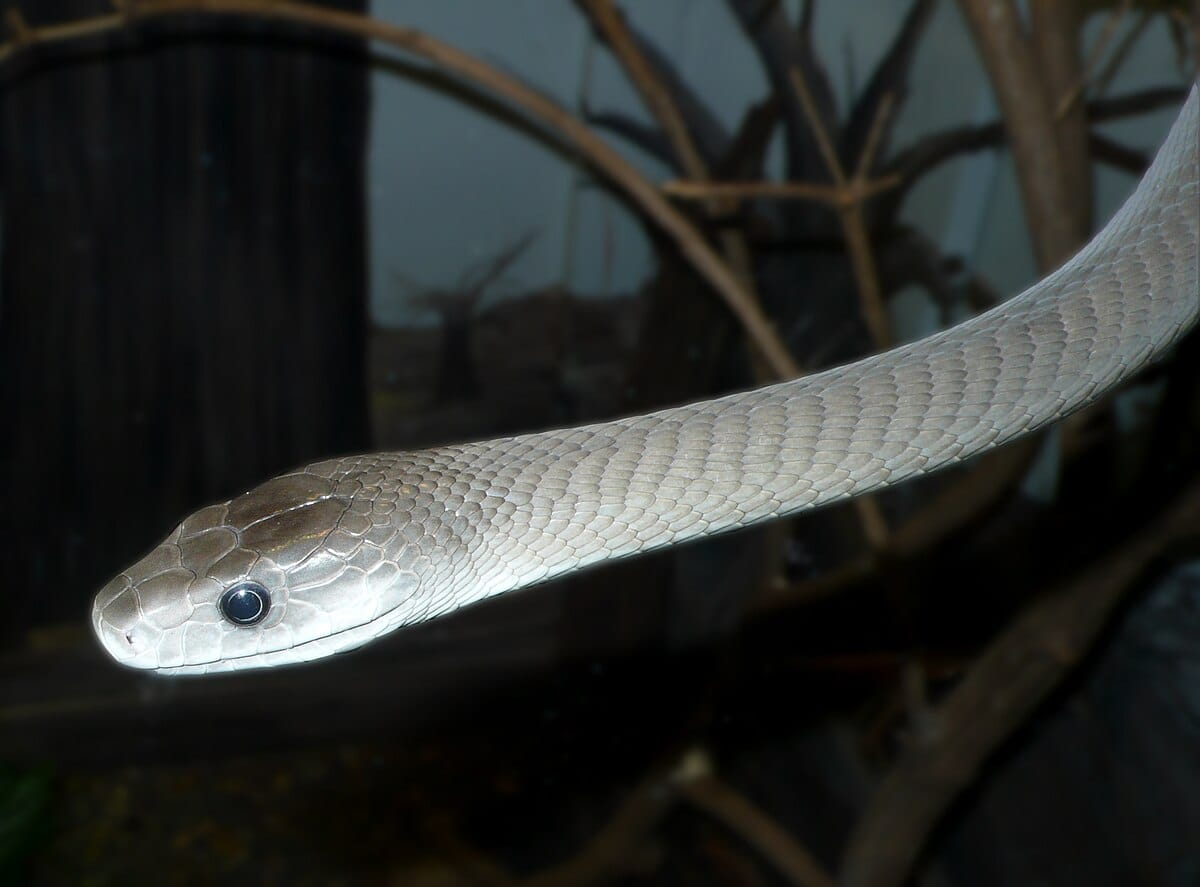
The Black Mamba is Africa’s fastest and arguably most feared snake. Its deadly speed, potent venom, and bold defense behavior have earned it a near-mythical status. Despite the name, its body is not black—it’s usually gray or olive; the inside of its mouth is jet black, inspiring its ominous title.
Identification
Black Mambas can reach up to 4.5 meters (14 ft) in length. They are sleek, agile, and capable of raising a third of their body off the ground when threatened. Their coffin-shaped head and piercing dark eyes give them a fierce appearance.
Venom and Behavior
This snake’s venom is an extremely fast-acting neurotoxin. Without treatment, a bite can cause death within 30 minutes. Fortunately, antivenom and rapid medical response have reduced fatalities. Despite its reputation, the Black Mamba is not naturally aggressive—it attacks only when cornered or provoked.
Habitat and Range
It inhabits savannas, rocky hills, and open woodlands across sub-Saharan Africa. The species prefers warm, dry areas and shelters in termite mounds or abandoned burrows.
Fun Fact
The Black Mamba can slither at speeds up to 20 km/h (12 mph), making it one of the fastest snakes on Earth.
4. Russell’s Viper (Daboia russelii)
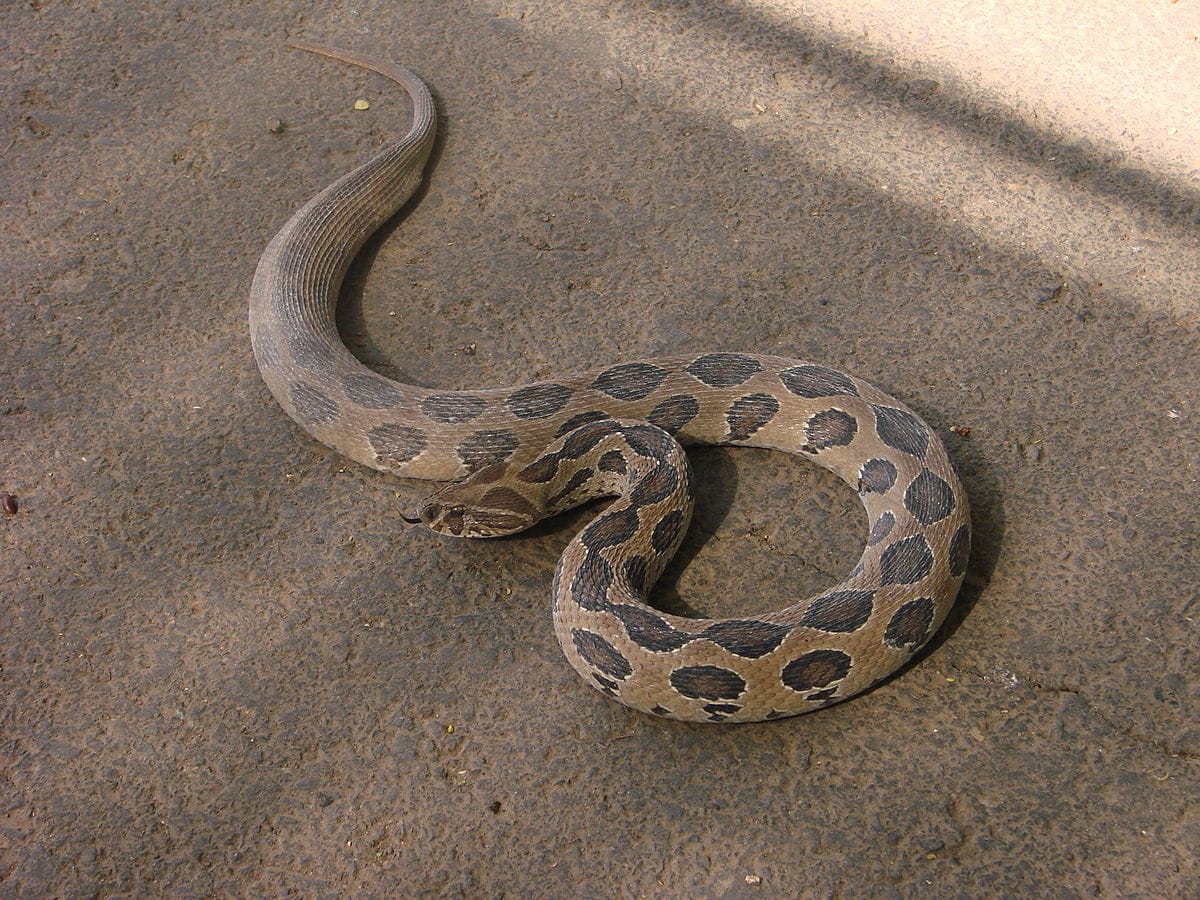
Among the most dangerous snakes in Asia, Russell’s Viper is responsible for thousands of bites annually. Its potent venom, combined with its tendency to live near human settlements, makes it a serious threat in India, Sri Lanka, and Southeast Asia.
Identification
This viper is heavy-bodied, reaching 1–1.5 meters (3–5 ft). It has a distinct chain-like pattern of dark brown spots outlined in white or yellow. The head is triangular with a blunt snout, and the eyes are large with vertical pupils.
Venom and Behavior
Russell’s Viper venom is hemotoxic, causing massive tissue damage, internal bleeding, and kidney failure. The snake is nocturnal and often lies coiled, camouflaged in leaf litter. When disturbed, it produces a loud, hissing sound as a warning before striking with incredible speed.
Habitat and Range
Found throughout South and Southeast Asia, this viper prefers grasslands, plantations, and agricultural fields. Its adaptability has unfortunately led to frequent encounters with humans.
Fun Fact
The species is named after Scottish herpetologist Patrick Russell, one of the first scientists to study Indian snakes in detail.
5. Eastern Brown Snake (Pseudonaja textilis)
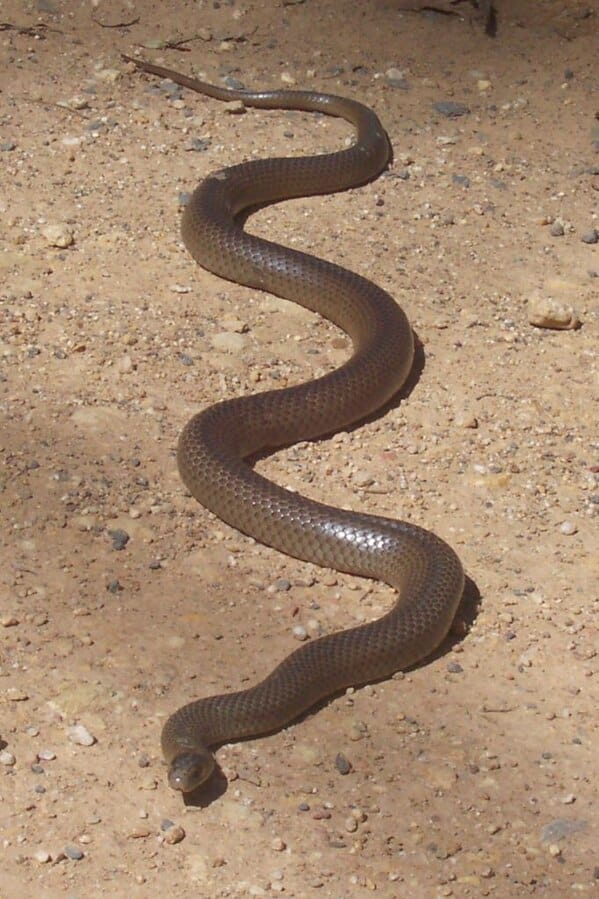
The Eastern Brown Snake is the second-most venomous land snake in the world, found primarily in Australia. Fast-moving, alert, and unpredictable, it accounts for the majority of snakebite fatalities in the country—though most occur when humans attempt to capture or kill it.
Identification
This slender species grows between 1.5 and 2 meters (5–6.5 ft). Its coloration ranges from pale tan to dark brown, often with a lighter belly. Juveniles may have distinct banding patterns that fade as they mature.
Venom and Behavior
The venom is a lethal mix of neurotoxins and coagulants, causing rapid paralysis and cardiac arrest if untreated. However, the Eastern Brown Snake is not naturally aggressive; it relies on speed and escape rather than confrontation. When threatened, it raises its head and upper body, forming an S-shape before striking multiple times in quick succession.
Habitat and Range
This species thrives in open grasslands, farms, and suburban areas across eastern and southern Australia. It’s highly adaptable and often hunts rodents—ironically benefiting farmers by controlling pest populations.
Fun Fact
The Eastern Brown Snake is responsible for more human deaths in Australia than any other snake species, yet most encounters end peacefully when left undisturbed.
6. Saw-Scaled Viper (Echis carinatus)
The Saw-Scaled Viper is a small but deadly snake found across Africa, the Middle East, and South Asia. Despite its modest size, it’s responsible for more human deaths annually than almost any other species, mainly because it thrives in densely populated areas. Its name comes from the unique rasping or “sizzling” sound it makes by rubbing its serrated scales together—a clear warning before it strikes.
Identification
Typically measuring around 60–80 cm (2–2.5 ft), this viper has a stout body covered in rough, keeled scales that give it a textured appearance. Its coloration varies with habitat, ranging from sandy beige to reddish brown, with darker zigzag or hourglass patterns along the back for camouflage. The head is distinct and triangular with a short, blunt snout.
Venom and Behavior
The Saw-Scaled Viper’s venom is a potent cocktail of hemotoxins that cause severe bleeding, tissue necrosis, and coagulation disorders. Despite its size, it delivers rapid multiple strikes when provoked. Its defensive “sidewinding” movement and loud hissing make it easily recognizable in the field. Fortunately, modern antivenom treatments have greatly reduced fatalities where medical care is accessible.
Habitat and Range
This snake is widely distributed across dry savannas, scrublands, and rocky deserts in India, Pakistan, the Arabian Peninsula, and parts of Africa. It prefers loose soil or sand where it can easily burrow and hide during the day, emerging at night to hunt small rodents, lizards, and insects.
Fun Fact
The Saw-Scaled Viper is often heard before it’s seen. Its distinctive “sawing” sound—produced by rubbing its scales together—is both its defense and its warning system.
7. Coastal Taipan (Oxyuranus scutellatus)
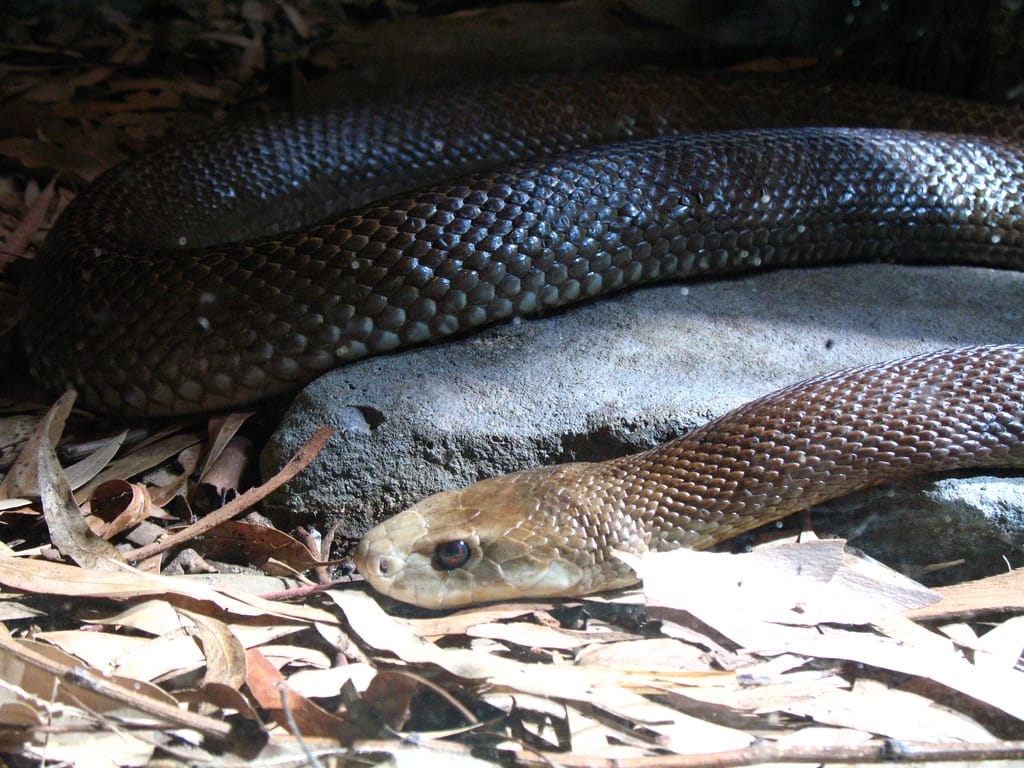
The Coastal Taipan is one of Australia’s most notorious snakes, rivaling its inland cousin in potency. Agile, intelligent, and lightning-fast, this species combines deadly venom with remarkable precision. It’s feared throughout northern and eastern Australia but admired by herpetologists for its complexity and adaptability.
Identification
Adults typically reach 1.5–2 meters (5–6.5 ft) in length, with a slender body and a narrow, coffin-shaped head distinct from the neck. Its coloration ranges from light brown to reddish or olive, depending on the season and region. The belly is creamy white or yellowish, often with orange speckles.
Venom and Behavior
The Coastal Taipan’s venom is among the most toxic of any land snake. It contains powerful neurotoxins and procoagulants that can cause death in under an hour if untreated. Early symptoms include headache, nausea, and paralysis. Thankfully, effective antivenom and awareness have drastically reduced fatal cases. Despite its reputation, the Coastal Taipan is not aggressive by nature and prefers to flee when possible.
Habitat and Range
This species inhabits tropical and subtropical coastal regions of northern and eastern Australia, as well as parts of New Guinea. It thrives in sugarcane fields, forests, and grasslands, often preying on rats and bandicoots. Its affinity for agricultural zones occasionally brings it into conflict with humans.
Fun Fact
Before the development of its antivenom in 1956, nearly all Taipan bites were fatal—earning it a place in Australia’s folklore as the “silent reaper.”
8. Fer-de-Lance (Bothrops asper)
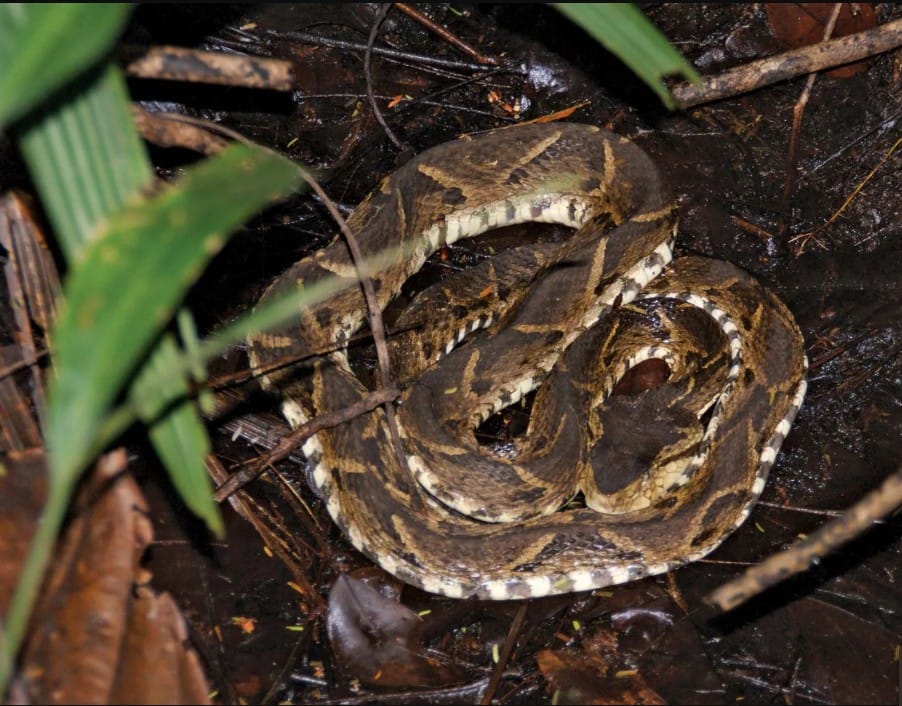
The Fer-de-Lance is Central and South America’s most infamous viper. Its name, French for “spearhead,” references the triangular shape of its head and its swift, accurate strikes. Despite its beauty, this snake is responsible for more human bites in Latin America than any other species.
Identification
Fer-de-Lance snakes can reach 2.5 meters (8 ft) in length, with muscular bodies and cryptic coloration that blends into forest floors. Their scales display complex patterns of brown, gray, and black, forming diamond or hourglass shapes. The head is large and well-defined, with heat-sensing pits between the eyes and nostrils—an adaptation for locating warm-blooded prey.
Venom and Behavior
This viper’s venom is highly hemotoxic and cytotoxic, destroying tissue and blood cells upon contact. Victims experience intense pain, swelling, and internal bleeding. The Fer-de-Lance is primarily nocturnal, hunting rodents, birds, and amphibians. It’s easily agitated and quick to strike if startled, often without warning—a behavior that contributes to its deadly reputation.
Habitat and Range
It thrives in humid lowlands, plantations, and forested areas from southern Mexico to northern South America. Its adaptability to farmland ecosystems brings it into frequent contact with humans, especially agricultural workers.
Fun Fact
In some regions, locals call it “Terciopelo,” meaning “velvet,” due to the smooth, glossy texture of its scales that shimmer under light.
9. Eastern Diamondback Rattlesnake (Crotalus adamanteus)
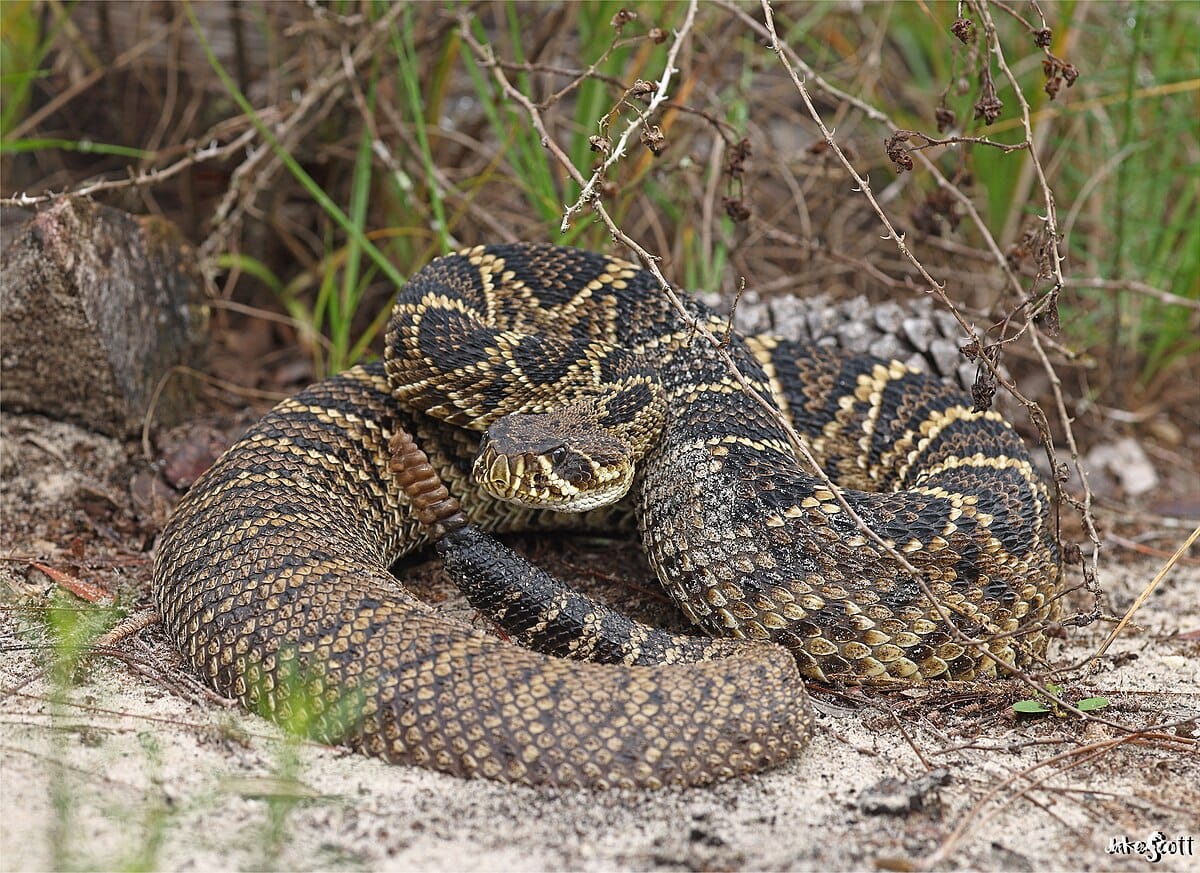
The Eastern Diamondback Rattlesnake is North America’s largest and most iconic venomous snake. Recognizable by its striking pattern and trademark rattle, it’s a symbol of southern wilderness and a critical predator in its ecosystem. Despite its fearsome reputation, it’s a surprisingly calm species when left alone.
Identification
Adults typically measure 1.2–2.4 meters (4–8 ft) long and can weigh over 4 kg (9 lbs). Their backs display a series of dark brown or black diamond-shaped blotches outlined in cream or yellow. The body is heavy and muscular, designed for powerful strikes. The tail ends with a keratin rattle that produces the characteristic buzz when shaken.
Venom and Behavior
The venom is a potent mix of hemotoxins and enzymes that cause rapid tissue damage and disrupt blood clotting. Though capable of delivering a fatal dose, the Eastern Diamondback rarely strikes unless provoked. When threatened, it coils, rattles, and holds its ground—a display meant more to warn than to attack.
Habitat and Range
This rattlesnake inhabits pine forests, palmetto scrub, and coastal dunes in the southeastern United States, especially Florida and Georgia. It’s a top predator in its environment, feeding mainly on rabbits and small mammals.
Fun Fact
Despite its size and strength, the Eastern Diamondback plays a vital role in controlling rodent populations, helping maintain balance in fragile ecosystems.
10. Banded Krait (Bungarus fasciatus)
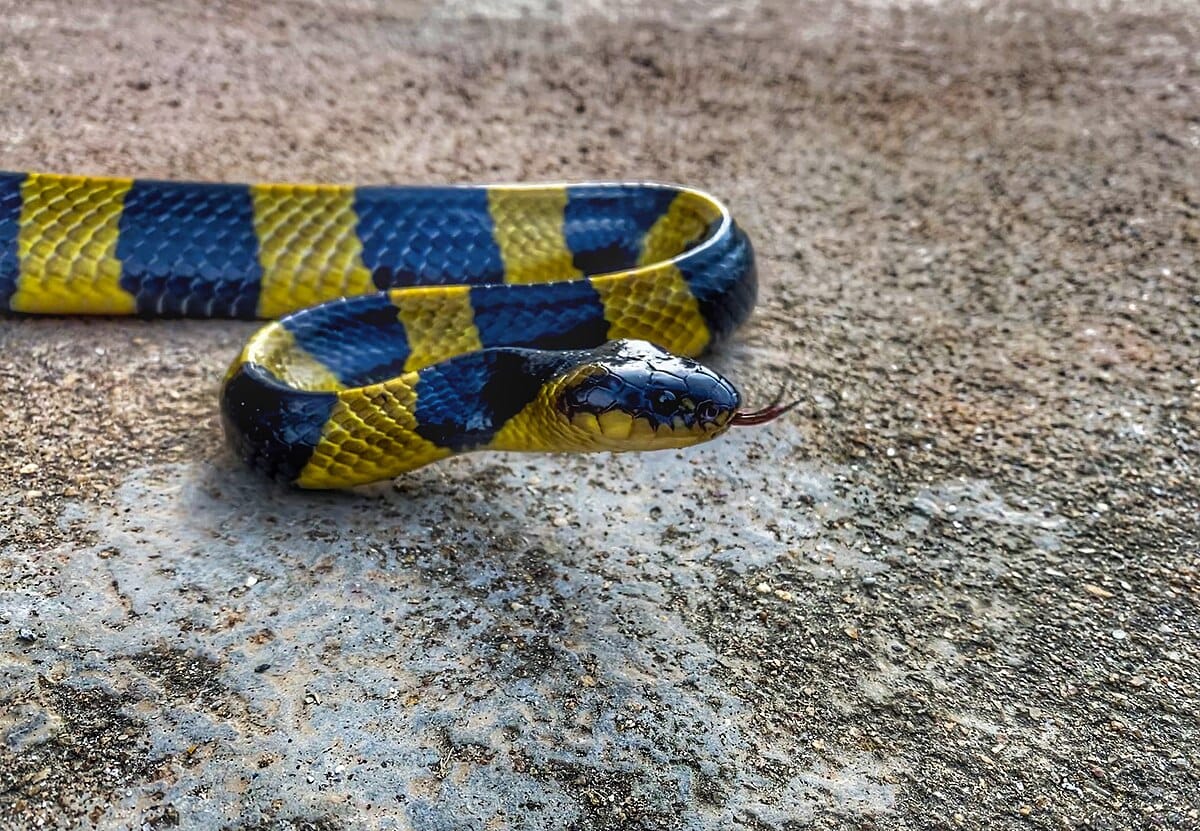
The Banded Krait is a brilliantly colored but highly venomous snake native to South and Southeast Asia. Its distinctive black-and-yellow body makes it instantly recognizable and often mistaken for harmless species—a potentially fatal error. Fortunately, the Banded Krait is nocturnal and reclusive, rarely seen during the day.
Identification
This species can grow up to 2.2 meters (7 ft) long, with a glossy body encircled by bold black and yellow bands. Its triangular cross-section, small head, and blunt tail distinguish it from other snakes. The smooth scales reflect light beautifully, giving it a polished, almost plastic appearance.
Venom and Behavior
The Banded Krait’s venom is neurotoxic, attacking the nervous system and causing respiratory failure in severe cases. It’s a slow-moving snake that rarely bites unless severely provoked. Its defensive posture includes hiding its head under its coils while lifting and waving its tail as a decoy. Most bites occur at night when people accidentally step on them in rural areas.
Habitat and Range
It inhabits rice fields, forests, and riverbanks across India, Myanmar, Thailand, Cambodia, and southern China. The species feeds mainly on other snakes, including smaller kraits and even cobras.
Fun Fact
The bright coloration of the Banded Krait is aposematic—serving as a visual warning to predators that it is highly venomous and should not be approached.
11. Death Adder (Acanthophis spp.)
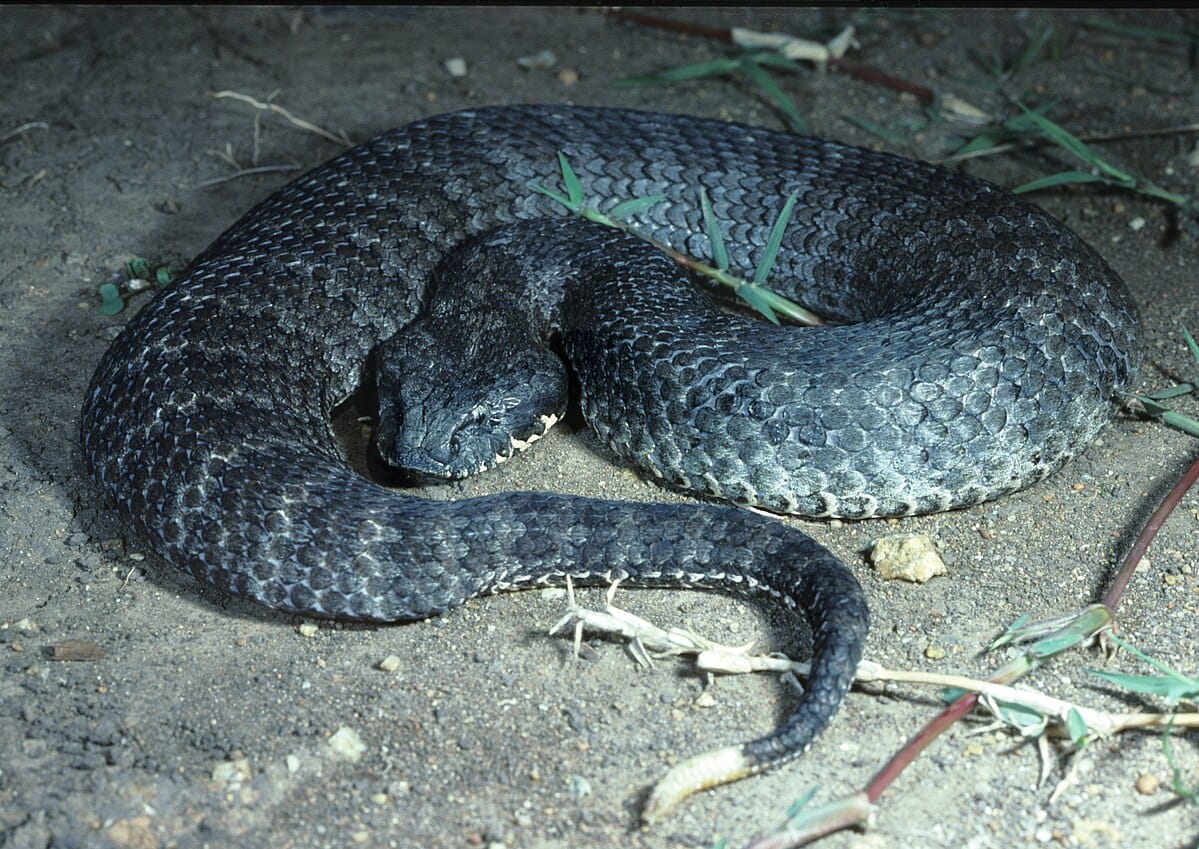
The Death Adder is one of Australia’s most deceptive and efficient ambush predators. Despite its name, it’s not a true adder but rather an elapid—related to cobras and mambas. Its ability to blend seamlessly into leaf litter, combined with lightning-fast strikes, makes it one of the most fascinating venomous snakes in the world.
Identification
Death Adders have thick, stocky bodies with short tails and broad triangular heads. They typically measure between 60 and 100 cm (2–3.3 ft). Their coloration varies by habitat—gray, reddish-brown, or sandy—allowing them to camouflage perfectly against the forest floor. The tail ends with a distinctive lure-like tip that wiggles like a worm to attract prey.
Venom and Behavior
The Death Adder delivers one of the fastest strikes among snakes—often within 0.15 seconds. Its venom is strongly neurotoxic, causing paralysis and respiratory failure if untreated. Before antivenom became widely available, bites were often fatal. The snake’s hunting strategy involves lying motionless for hours, waiting for unsuspecting prey to come close enough to strike. Once it captures a victim, it releases and waits for the venom to take effect before swallowing the prey whole.
Habitat and Range
Found throughout Australia and New Guinea, Death Adders inhabit forests, grasslands, and scrub regions. They prefer dry, open environments where leaf litter and sand provide perfect cover for ambush.
Fun Fact
Unlike most snakes that flee when disturbed, Death Adders rely entirely on camouflage, remaining perfectly still even when approached—a trait that makes them particularly dangerous to humans who accidentally step too close.
12. Gaboon Viper (Bitis gabonica)
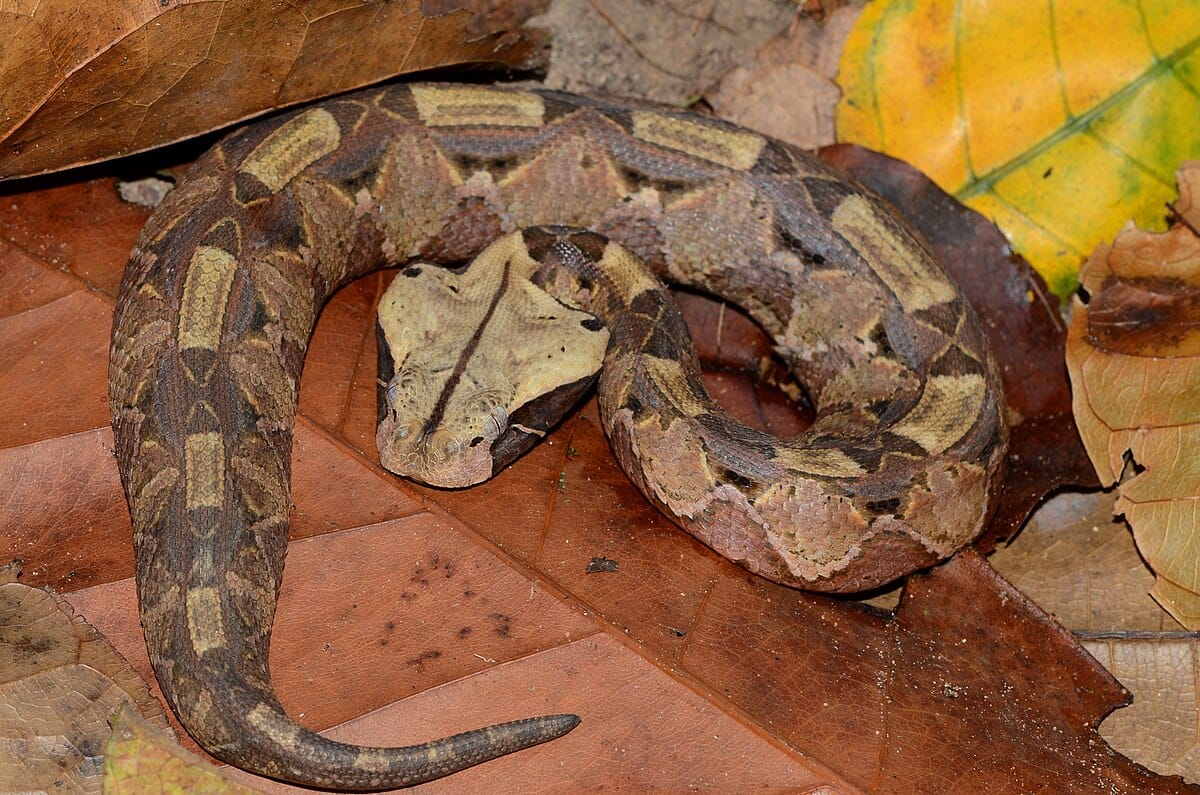
The Gaboon Viper of central and western Africa is a masterpiece of natural design. With its striking coloration, enormous fangs, and calm disposition, it’s both feared and admired. Though it rarely bites humans, when it does, its venom yield is the largest of any snake on Earth.
Identification
This heavy-bodied snake can reach 2 meters (6.5 ft) and weigh over 10 kg (22 lbs). Its intricate mosaic of purples, browns, and creams perfectly mimics leaf litter, making it almost invisible in the forest understory. The Gaboon Viper’s head is large and triangular with distinct horn-like scales above the nostrils. Its fangs can exceed 5 cm (2 inches)—the longest of any venomous snake.
Venom and Behavior
The venom contains a mix of hemotoxins and cytotoxins that destroy blood cells and tissue, leading to massive swelling and pain. However, the Gaboon Viper is generally docile and slow-moving, relying on camouflage instead of aggression. It strikes only when severely provoked. Because of its calm nature, most encounters end peacefully unless someone accidentally steps on it.
Habitat and Range
It thrives in tropical rainforests, plantations, and forest edges from Nigeria to Kenya and southward to Angola. It’s most active during the early evening, hunting small mammals and birds.
Fun Fact
Despite its formidable venom and fangs, the Gaboon Viper is often described by herpetologists as a “gentle giant”—a true paradox of beauty and danger.
13. Puff Adder (Bitis arietans)
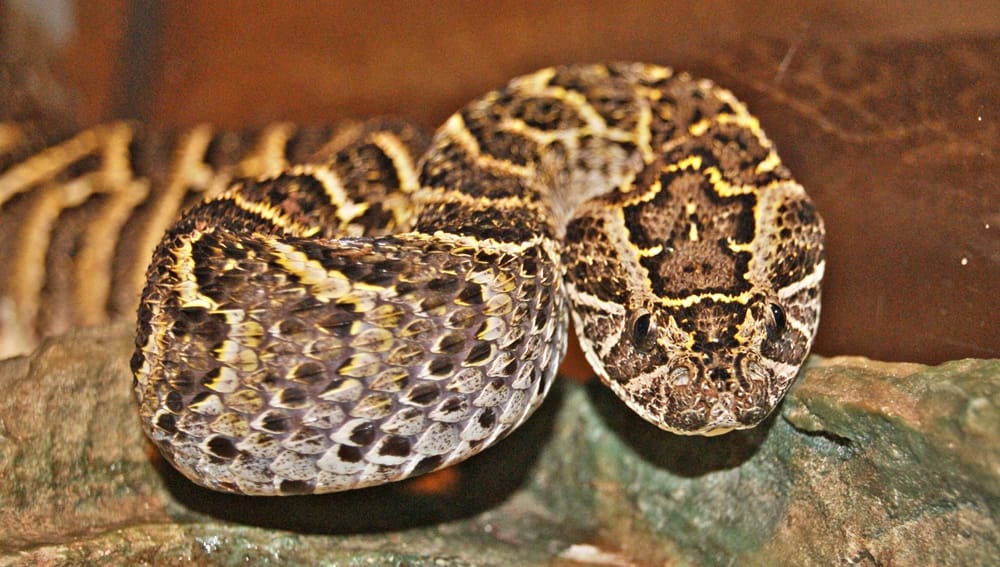
The Puff Adder is one of Africa’s most widespread and dangerous snakes. Responsible for more bites and fatalities than any other African species, it’s highly adaptable, inhabiting a wide range of environments from deserts to forests. Its name comes from its habit of inflating its body and producing a loud hissing “puff” when threatened.
Identification
Puff Adders are stout snakes averaging 1–1.5 meters (3–5 ft) in length, with chevron-like brown and yellow patterns across the back. The head is broad and distinct, with vertical pupils and rough scales. Its thick body allows it to store large amounts of venom, making each bite potentially deadly.
Venom and Behavior
The venom is mainly cytotoxic, causing severe tissue damage and swelling. Puff Adders are ambush predators, remaining motionless for hours before striking prey that passes nearby. They strike quickly and often multiple times in succession. Because they rarely retreat and rely on camouflage, accidental human encounters are common, especially in grassy areas.
Habitat and Range
Found across sub-Saharan Africa, from savannas to rocky hills, this species is extremely adaptable. It can survive in high altitudes and even semi-arid deserts. Puff Adders feed primarily on small mammals, birds, and amphibians.
Fun Fact
Despite being slow and heavy-bodied, the Puff Adder can strike with astonishing speed—comparable to lighter, more agile species.
14. Coral Snake (Micrurus spp.)
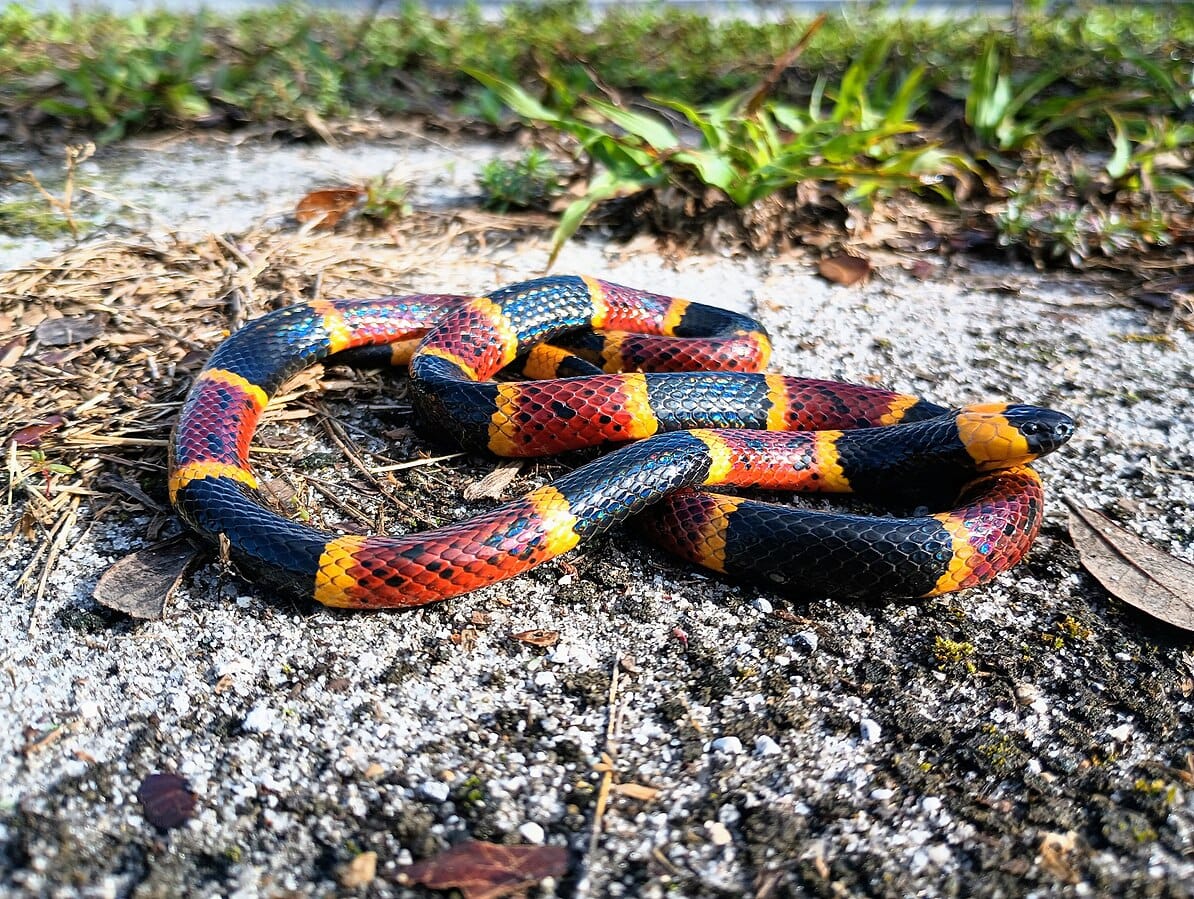
The Coral Snake is one of the most colorful yet misunderstood venomous snakes in the Americas. Its vivid red, yellow, and black rings serve as a clear warning to predators: “Don’t touch!” Although it rarely bites humans, its venom is among the most potent neurotoxins in the Western Hemisphere.
Identification
Coral Snakes are slender, measuring about 60–120 cm (2–4 ft). They are easily recognized by their distinct color pattern: red, yellow (or white), and black bands that encircle the body. The pattern can vary between species, but a common North American mnemonic—“Red touch yellow, kill a fellow; red touch black, friend of Jack”—helps distinguish venomous coral snakes from harmless mimics like king snakes.
Venom and Behavior
The venom is highly neurotoxic, causing paralysis and respiratory failure if left untreated. Coral Snakes have small, fixed fangs that deliver venom through a chewing motion rather than a single strike. They are reclusive and spend most of their time underground or hidden under leaves. Bites are rare, but when they occur, medical attention is crucial, as symptoms may take hours to appear.
Habitat and Range
These snakes inhabit a wide range of environments from the southern United States to northern South America. They favor forests, sandy soils, and marshy areas where they can burrow or hide.
Fun Fact
Coral Snakes’ bright coloration inspired some of nature’s most famous cases of mimicry—non-venomous snakes that evolve to copy their warning colors for protection.
15. Copperhead (Agkistrodon contortrix)
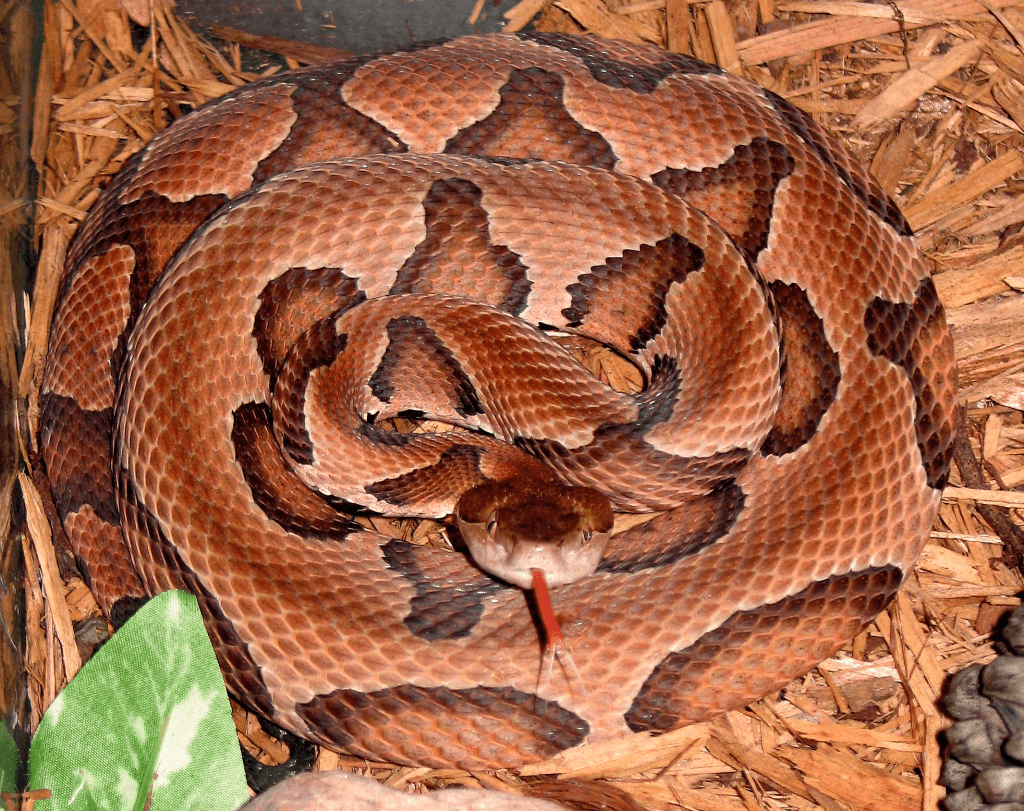
The Copperhead is one of North America’s most familiar venomous snakes. Known for its beautiful coppery-brown coloration and calm temperament, it’s responsible for more bites in the U.S. than any other venomous snake—but thankfully, its venom is relatively mild and rarely fatal.
Identification
This pit viper grows 60–90 cm (2–3 ft) long and has a stout body with distinctive hourglass-shaped bands of light brown and dark copper. The head is broad and triangular, with heat-sensing pits between the eyes and nostrils. Its camouflage allows it to blend perfectly with fallen leaves, often causing accidental encounters with hikers.
Venom and Behavior
The venom is hemotoxic, causing pain and swelling but rarely leading to serious complications. Copperheads are generally docile and will freeze rather than flee, relying on camouflage. When disturbed, they may vibrate their tails rapidly—a warning behavior similar to rattlesnakes. Most bites occur when the snake is accidentally stepped on or handled.
Habitat and Range
They are found throughout the eastern and central United States, thriving in forests, rocky hillsides, and near streams. Copperheads primarily feed on small rodents, frogs, and insects.
Fun Fact
Interestingly, the venom of the Copperhead has been studied for potential use in cancer treatment due to compounds that may inhibit tumor growth.
16. Cottonmouth (Agkistrodon piscivorus)
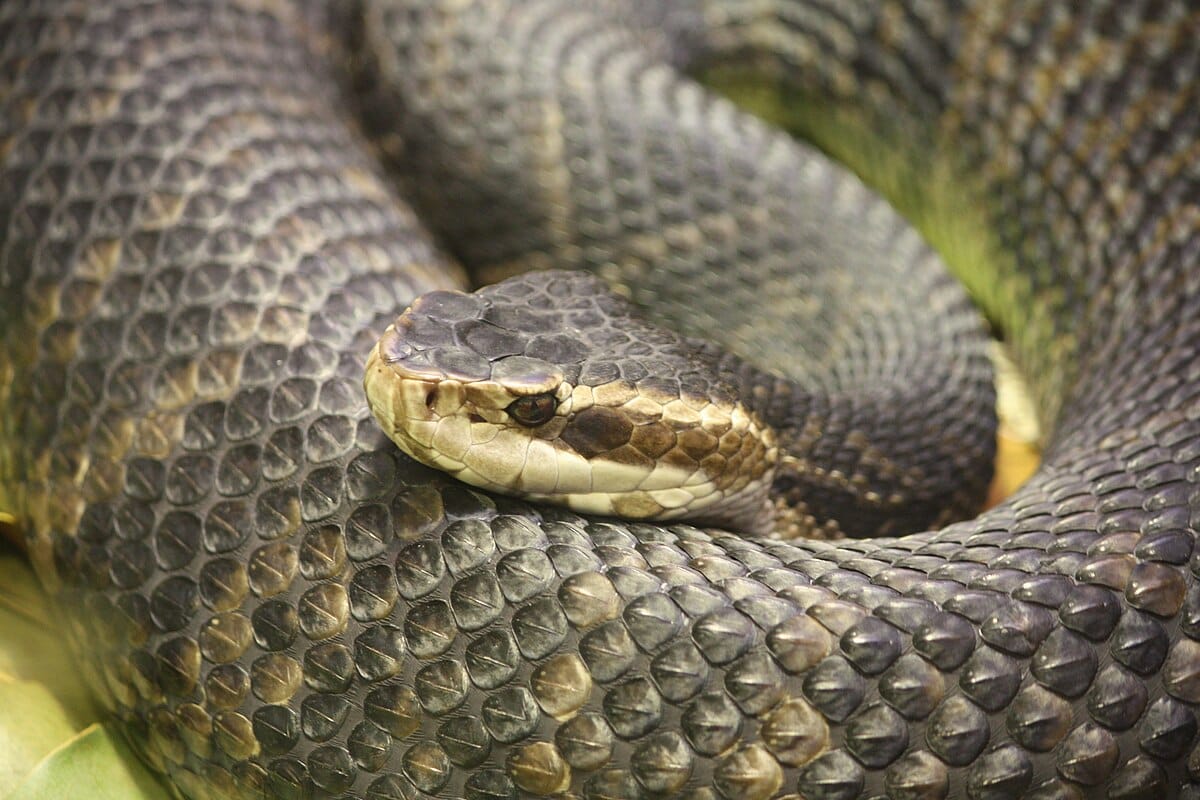
The Cottonmouth, also known as the Water Moccasin, is one of the most notorious snakes in the southeastern United States. It’s a semi-aquatic pit viper famous for the white interior of its mouth—displayed as a defensive warning. Though its fearsome reputation often exceeds reality, the Cottonmouth is indeed a powerful predator with potent venom.
Identification
The Cottonmouth typically measures 60–120 cm (2–4 ft), with thick bodies and broad, triangular heads. Its coloration ranges from dark olive or brown to nearly black, often with faint banding. The eyes feature vertical pupils, and older adults may appear solid dark due to pigment buildup. Juveniles are more colorful, with a distinct yellow tail tip used to lure prey.
Venom and Behavior
The venom of a Cottonmouth is hemotoxic, breaking down blood cells and tissues, causing pain and swelling. However, fatalities are extremely rare thanks to modern medical treatment. Cottonmouths are defensive but not aggressive—they prefer to stand their ground, opening their mouths to reveal the bright white interior (hence the name). This display often prevents conflict rather than inviting it.
Habitat and Range
They inhabit wetlands, swamps, lakes, and rivers across the southeastern United States, from Virginia to Texas. Cottonmouths are strong swimmers and can be seen basking near water bodies or floating with only their heads above the surface.
Fun Fact
Cottonmouths are one of the few venomous snakes comfortable in aquatic environments—they can even hunt fish and amphibians underwater.
17. Tiger Snake (Notechis scutatus)
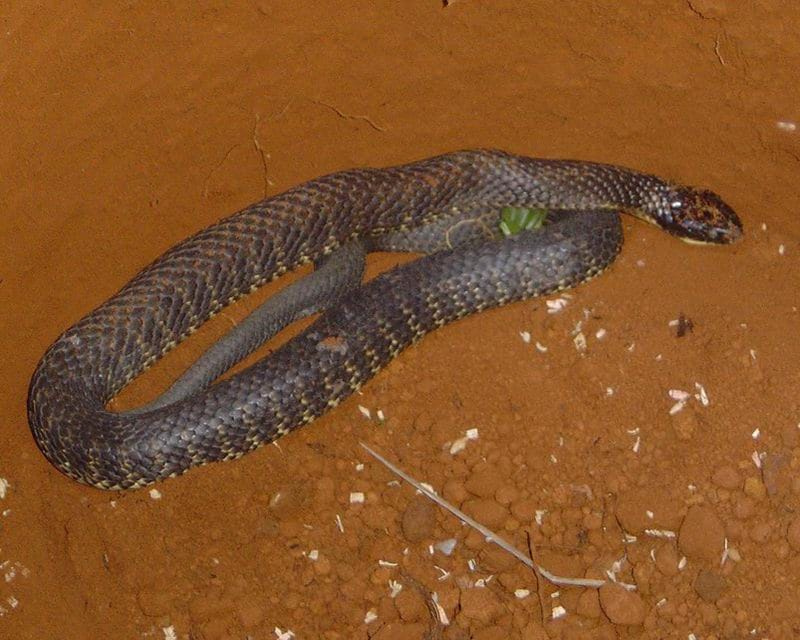
The Tiger Snake is an iconic Australian species, easily recognized by its striking banded pattern. With a venom potent enough to kill a human in minutes, it’s one of Australia’s most dangerous snakes—but also one of the most fascinating due to its diverse color variations and adaptability.
Identification
Tiger Snakes grow between 1 and 1.8 meters (3–6 ft). They display alternating dark and light bands resembling a tiger’s stripes, though the intensity of these markings can vary greatly. Some individuals are nearly black. Their heads are broad and slightly distinct from the neck, and their scales are smooth, giving them a glossy appearance.
Venom and Behavior
The venom contains potent neurotoxins and coagulants that can lead to paralysis and organ failure. Before antivenom became available, bites were often fatal. Fortunately, Tiger Snakes usually avoid confrontation, preferring to flee when threatened. They will flatten their necks and hiss loudly if cornered, showing their readiness to strike.
Habitat and Range
These snakes are found throughout southern Australia, including Tasmania. They prefer wetlands, grasslands, and coastal regions but can also adapt to farmland and suburban areas. Their diet consists mainly of frogs, birds, and small mammals.
Fun Fact
Despite their fearsome reputation, Tiger Snakes play a crucial ecological role by controlling rodent populations and maintaining ecosystem balance.
18. Mojave Rattlesnake (Crotalus scutulatus)
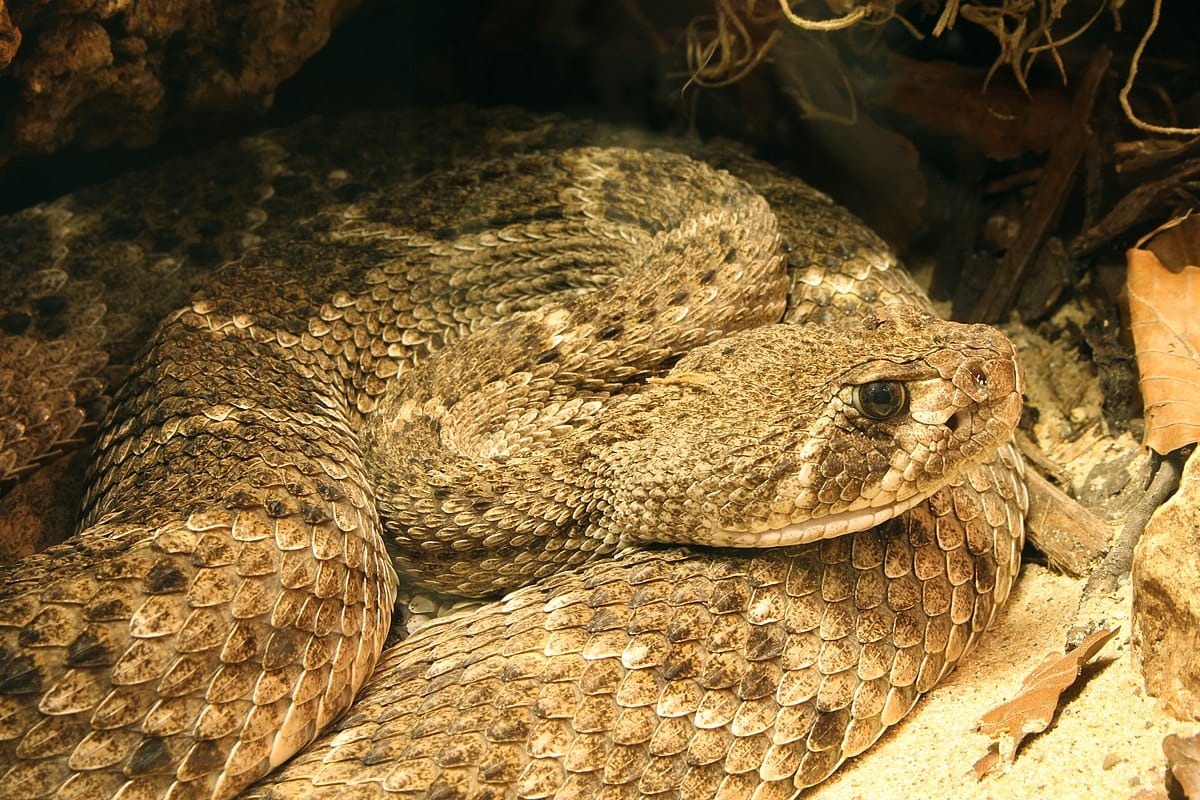
The Mojave Rattlesnake is often called the most venomous rattlesnake in North America. Its venom is a powerful cocktail of neurotoxins and hemotoxins, making it significantly more dangerous than many of its close relatives. Found in the deserts of the southwestern United States and Mexico, this species is both feared and respected by herpetologists.
Identification
Mojave Rattlesnakes measure 80–120 cm (2.5–4 ft). They typically have a greenish or brown hue, earning some populations the nickname “Mojave green.” The body bears dark diamond-shaped patterns similar to a Western Diamondback, but the Mojave can be distinguished by the pattern of light and dark bands on the tail—the lighter bands are typically wider than the dark ones.
Venom and Behavior
The venom of the Mojave Rattlesnake is highly neurotoxic, affecting the nervous system and potentially causing respiratory failure. It’s also hemotoxic, damaging tissue and blood cells. Despite this, Mojaves rarely strike unless provoked. They use their signature rattling tail as a warning, a behavior designed to prevent conflict rather than start one.
Habitat and Range
These snakes inhabit arid deserts, scrublands, and grasslands in the southwestern U.S., including California, Arizona, Nevada, and Texas, as well as northern Mexico. They are primarily nocturnal in hot seasons, becoming more active at dusk and dawn.
Fun Fact
Scientists have discovered two distinct venom types in Mojave Rattlesnakes—Type A (neurotoxic) and Type B (hemotoxic)—depending on the region. This variation makes studying their venom evolution particularly fascinating.
19. Boomslang (Dispholidus typus)
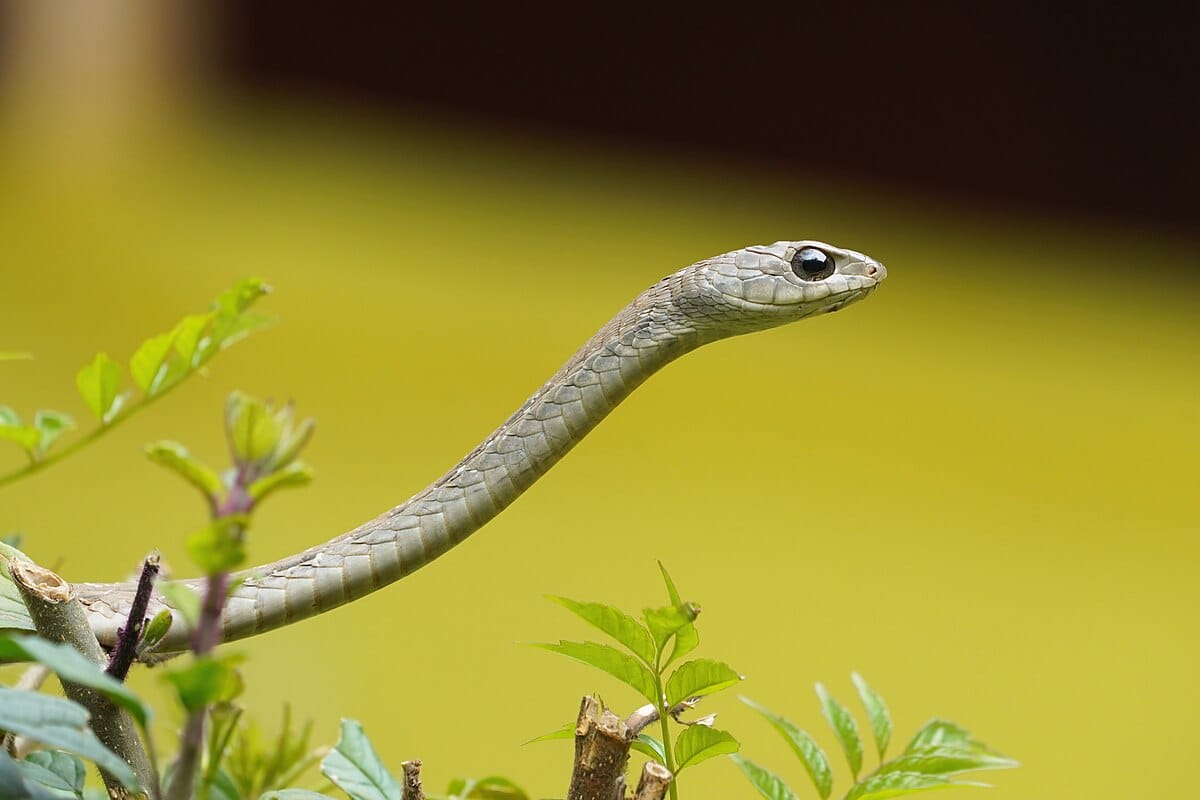
The Boomslang—meaning “tree snake” in Afrikaans—is a slender, arboreal species native to sub-Saharan Africa. Though it appears harmless and shy, it possesses one of the most potent venoms of any rear-fanged snake in the world.
Identification
Boomslangs are long and thin, reaching up to 2 meters (6.5 ft). Their large eyes and rounded pupils give them excellent vision, ideal for spotting prey among tree branches. Males are usually bright green with black-edged scales, while females are brown or olive-colored—an example of strong sexual dimorphism.
Venom and Behavior
Boomslang venom is hemotoxic, disrupting blood clotting and leading to internal bleeding. Symptoms may take hours to appear, which historically led victims to underestimate the danger. Fortunately, Boomslangs are extremely shy and rarely bite unless handled or threatened. When cornered, they inflate their necks and open their mouths in a defensive display.
Habitat and Range
They are found throughout much of sub-Saharan Africa, inhabiting savannas, forests, and farmlands. Their arboreal nature means they spend much of their lives in trees, hunting birds, lizards, and small mammals.
Fun Fact
The Boomslang’s venom became infamous after a herpetologist, Karl Schmidt, died from a bite in 1957 after refusing treatment—documenting his own symptoms until the end.
20. Bushmaster (Lachesis muta)
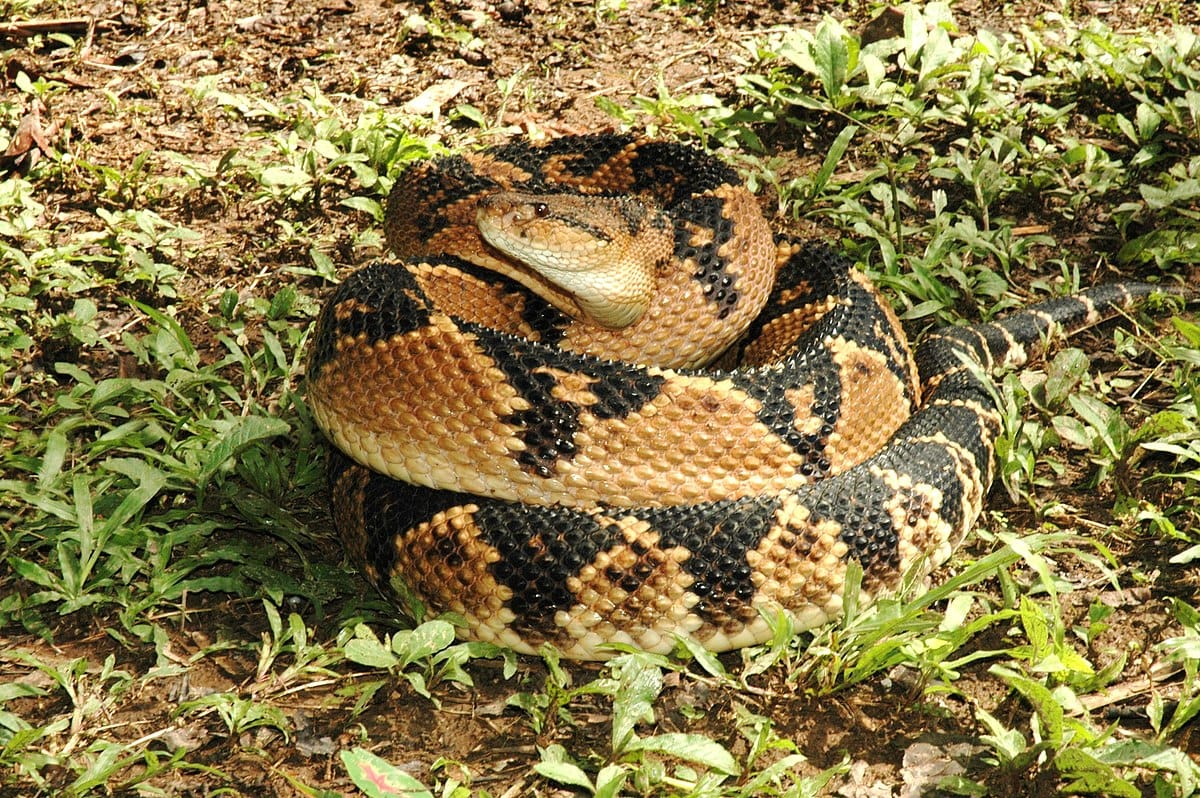
The Bushmaster is the largest venomous snake in the Americas and one of the most majestic reptiles in the world. Found in the tropical rainforests of Central and South America, it’s a symbol of both beauty and danger in the wild.
Identification
Bushmasters can grow up to 3.6 meters (12 ft), making them the longest pit vipers on Earth. Their bodies are covered in rough, diamond-shaped scales in shades of brown, tan, and black, forming a leaf-like pattern. The triangular head houses heat-sensing pits that help detect warm-blooded prey even in total darkness.
Venom and Behavior
The venom of the Bushmaster is primarily hemotoxic, causing pain, swelling, and tissue damage. Despite their size and lethal potential, Bushmasters are remarkably elusive and non-aggressive. They rely on camouflage and will often flee when approached. However, when cornered, they can deliver multiple powerful strikes in quick succession.
Habitat and Range
They inhabit dense tropical rainforests from Costa Rica and Panama to northern Brazil and Peru. Bushmasters prefer humid, undisturbed environments and are rarely seen due to their secretive habits.
Fun Fact
The Bushmaster’s scientific name, Lachesis, comes from Greek mythology—Lachesis was one of the three Fates, responsible for measuring the length of a person’s life, a fitting name for such a formidable serpent.
21. Philippine Cobra (Naja philippinensis)
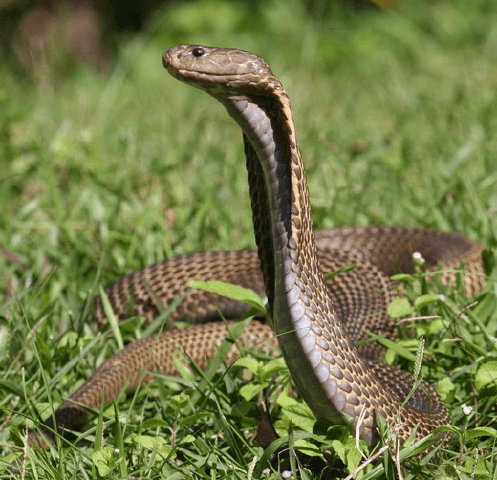
The Philippine Cobra is among the most dangerous snakes in Asia, renowned for its extremely potent neurotoxic venom and its ability to spit venom with precision. Native to the northern Philippines, this cobra commands both fear and respect from locals and herpetologists alike.
Identification
The Philippine Cobra is medium-sized, typically 1–1.5 meters (3–5 ft) long. It has a smooth-scaled body with a light brown to olive coloration that darkens with age. When threatened, it raises its hood—a signature cobra behavior—showcasing a distinctive circular pattern. Its round pupils and broad head give it an alert, intimidating appearance.
Venom and Behavior
The venom of the Philippine Cobra is almost entirely neurotoxic, attacking the nervous system and causing respiratory failure if untreated. It’s one of the few cobras that can accurately spit venom up to 3 meters (10 ft), targeting the eyes of its perceived aggressor. Despite this, the species prefers to avoid confrontation and will only spit or strike when provoked.
Habitat and Range
This cobra inhabits lowland forests, rice paddies, and agricultural areas throughout northern Luzon and nearby islands. It often lives close to human settlements due to the abundance of prey such as frogs, rats, and lizards.
Fun Fact
The Philippine Cobra’s venom is so toxic that even a small dose can be fatal within 30 minutes—one of the most dangerous venoms of any snake worldwide.
22. Malayan Krait (Bungarus candidus)
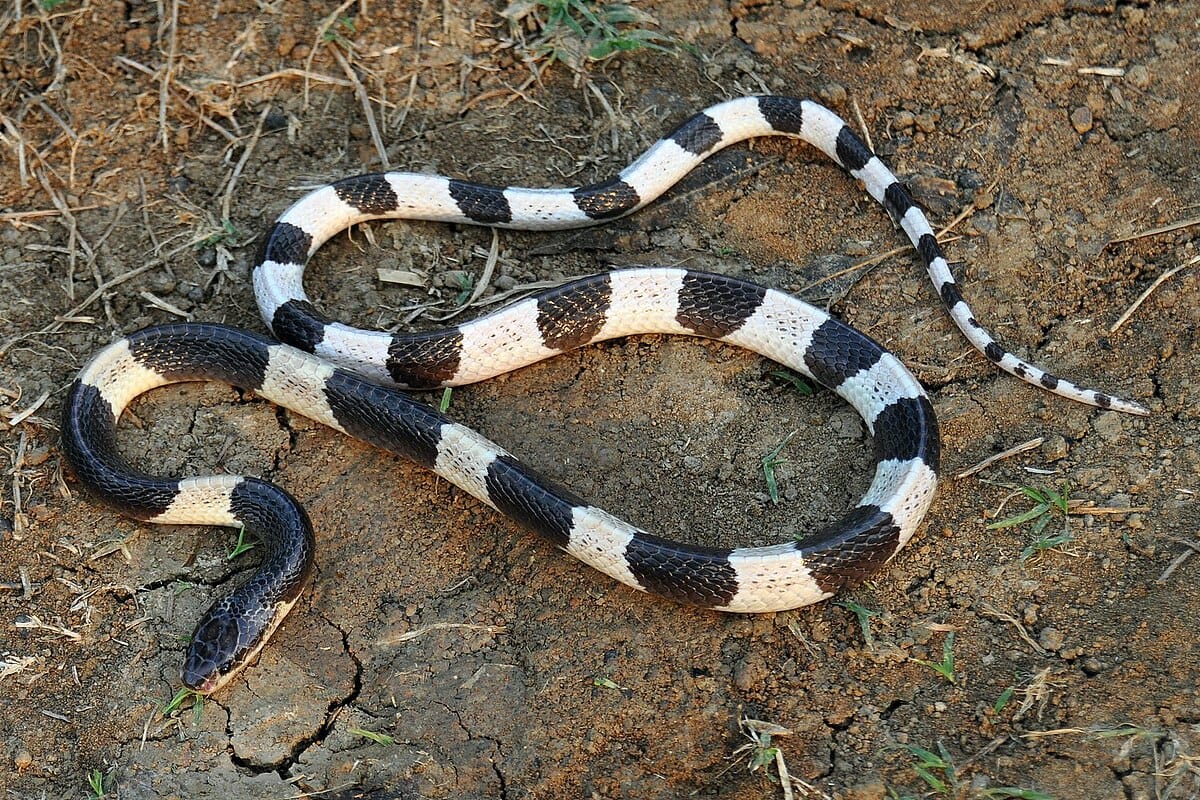
The Malayan Krait is a slender, nocturnal snake found throughout Southeast Asia. Although it looks beautiful with its contrasting black and white bands, it possesses an incredibly lethal neurotoxic venom. It’s sometimes referred to as the “Blue Krait” due to its shiny dark-blue hue.
Identification
Adults typically measure around 1–1.5 meters (3–5 ft) long. Their bodies are smooth and glossy, with alternating black and white bands. The head is slightly wider than the neck and rounded, giving them an elegant, streamlined appearance. The belly is usually white or cream-colored.
Venom and Behavior
The Malayan Krait’s venom contains powerful neurotoxins that interfere with communication between nerves and muscles, leading to paralysis and respiratory failure. What makes this species particularly dangerous is its calm demeanor—it rarely bites, but when it does, it’s usually during nighttime when disturbed. Victims often underestimate the severity of the bite, as initial pain may be mild.
Habitat and Range
This krait is found in Thailand, Cambodia, Vietnam, Indonesia, and Malaysia. It prefers lowland forests, agricultural fields, and areas near water. During the day, it hides under rocks or in burrows, emerging at night to hunt snakes, frogs, and small mammals.
Fun Fact
The Malayan Krait’s venom is so potent that untreated bites have a mortality rate exceeding 70%. Thankfully, its shy nature keeps encounters rare.
23. Red-bellied Black Snake (Pseudechis porphyriacus)
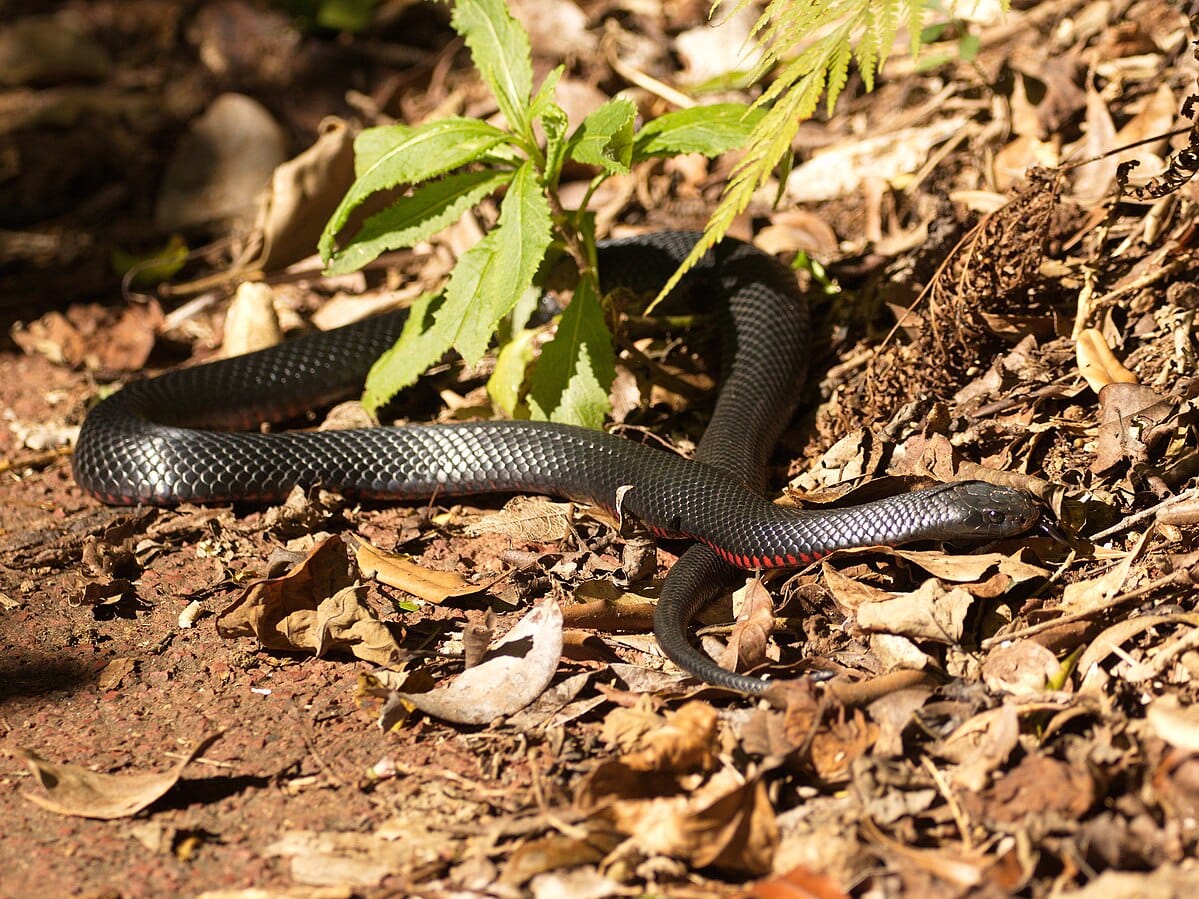
The Red-bellied Black Snake is a strikingly beautiful species native to eastern Australia. Its glossy black back contrasts with a vivid red or pink belly, making it one of the most visually distinctive snakes in the world. Despite its menacing look, it’s less aggressive than many other Australian venomous snakes.
Identification
This species can grow 1.5–2 meters (5–6.5 ft) in length. It has smooth, shiny scales, a slender head, and a bright red or orange underside. The vivid coloration warns potential predators of its venomous nature, a phenomenon known as aposematism.
Venom and Behavior
The venom contains a mix of neurotoxins and myotoxins that can cause pain, swelling, and muscle damage. Though rarely fatal, bites can lead to significant tissue injury. Red-bellied Black Snakes are typically shy and retreat when disturbed, though they may flatten their bodies and hiss if cornered.
Habitat and Range
They inhabit wetlands, riversides, and forests along Australia’s east coast, from Queensland to South Australia. They are often seen basking near water sources or hunting frogs and small fish.
Fun Fact
Red-bellied Black Snakes are immune to the venom of many other Australian snakes—including some they occasionally prey upon!
24. Eastern Coral Snake (Micrurus fulvius)
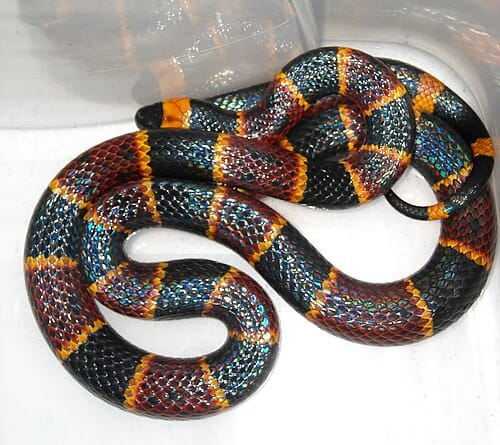
The Eastern Coral Snake is a small but deadly species native to the southeastern United States. Its vibrant red, yellow, and black bands make it one of the most recognizable snakes in North America—and also one of the most frequently misidentified due to similar-looking harmless species.
Identification
Eastern Coral Snakes typically reach 50–80 cm (1.5–2.5 ft) in length. They have bright, glossy rings of red, yellow, and black encircling their slender bodies. The key identification rule is “Red touches yellow, kill a fellow; red touches black, friend of Jack,” which helps differentiate them from non-venomous lookalikes like the Scarlet Kingsnake.
Venom and Behavior
Their venom is a powerful neurotoxin that interferes with nerve communication, potentially causing respiratory paralysis. Coral Snakes are secretive and spend most of their time underground or under leaf litter. Bites are rare because of their reclusive nature and small fangs, but when envenomation occurs, it requires immediate medical attention.
Habitat and Range
They are found across the southeastern U.S., particularly in Florida, Georgia, Alabama, and the Carolinas. They prefer wooded areas, sandy soils, and pine flatwoods, feeding mainly on other snakes and small lizards.
Fun Fact
Eastern Coral Snakes are among the few North American species that lay eggs instead of giving live birth, producing clutches of 3–12 eggs each summer.
25. Western Diamondback Rattlesnake (Crotalus atrox)
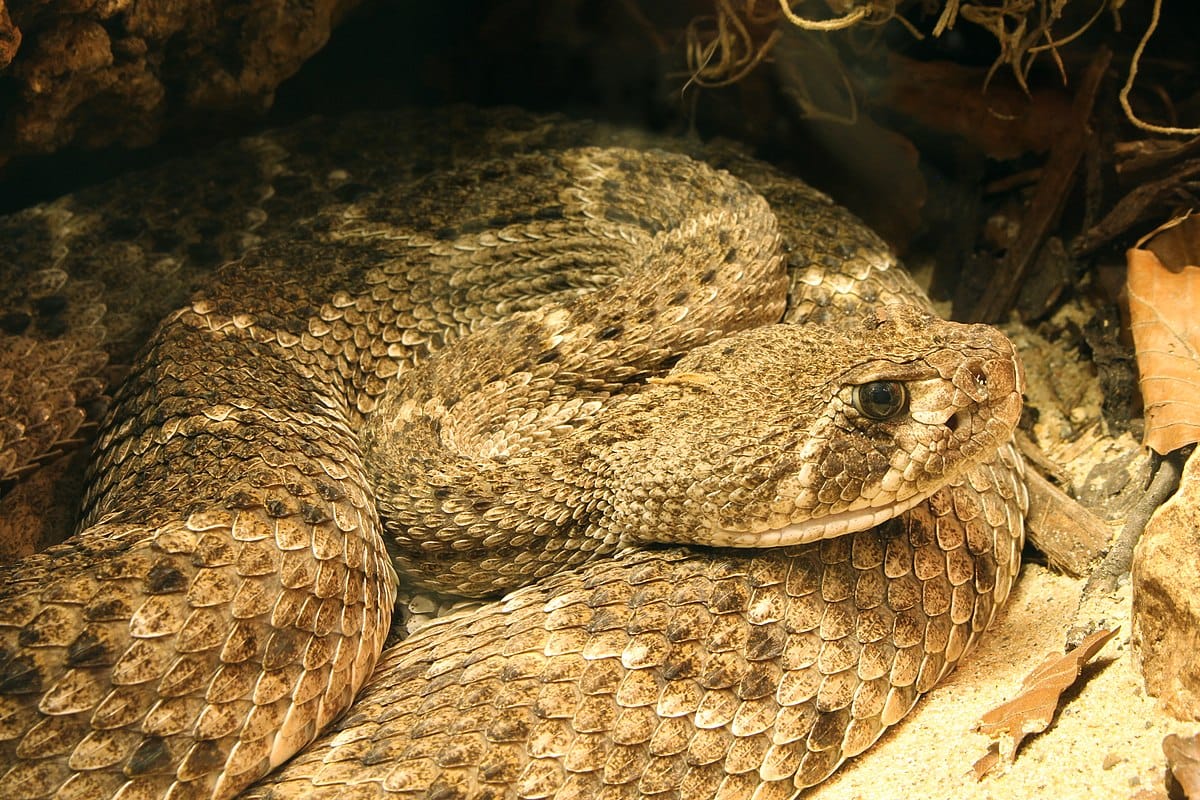
The Western Diamondback Rattlesnake is one of the most iconic snakes in the American Southwest. Known for its distinctive rattle and diamond-shaped back patterns, it’s a symbol of the desert and a vital part of its ecosystem.
Identification
These rattlesnakes typically grow between 1.2 and 1.8 meters (4–6 ft). Their grayish-tan bodies are adorned with dark diamond-shaped markings outlined in cream or white. The tail features alternating black and white bands just before the rattle—one of the easiest ways to identify this species.
Venom and Behavior
The venom is primarily hemotoxic, causing pain, swelling, and tissue necrosis. Although their bites can be serious, fatalities are rare with prompt treatment. Western Diamondbacks are defensive rather than aggressive—they use their signature rattle as a warning long before striking. Their strikes are powerful and accurate, capable of delivering large amounts of venom.
Habitat and Range
They inhabit deserts, prairies, and rocky canyons throughout the southwestern United States and northern Mexico. They are most active at dusk and dawn, feeding on rodents, birds, and lizards.
Fun Fact
The rattle of a Western Diamondback is made of interlocking keratin segments. Each time the snake sheds its skin, a new segment is added, allowing the rattle to grow over time.
26. Timber Rattlesnake (Crotalus horridus)
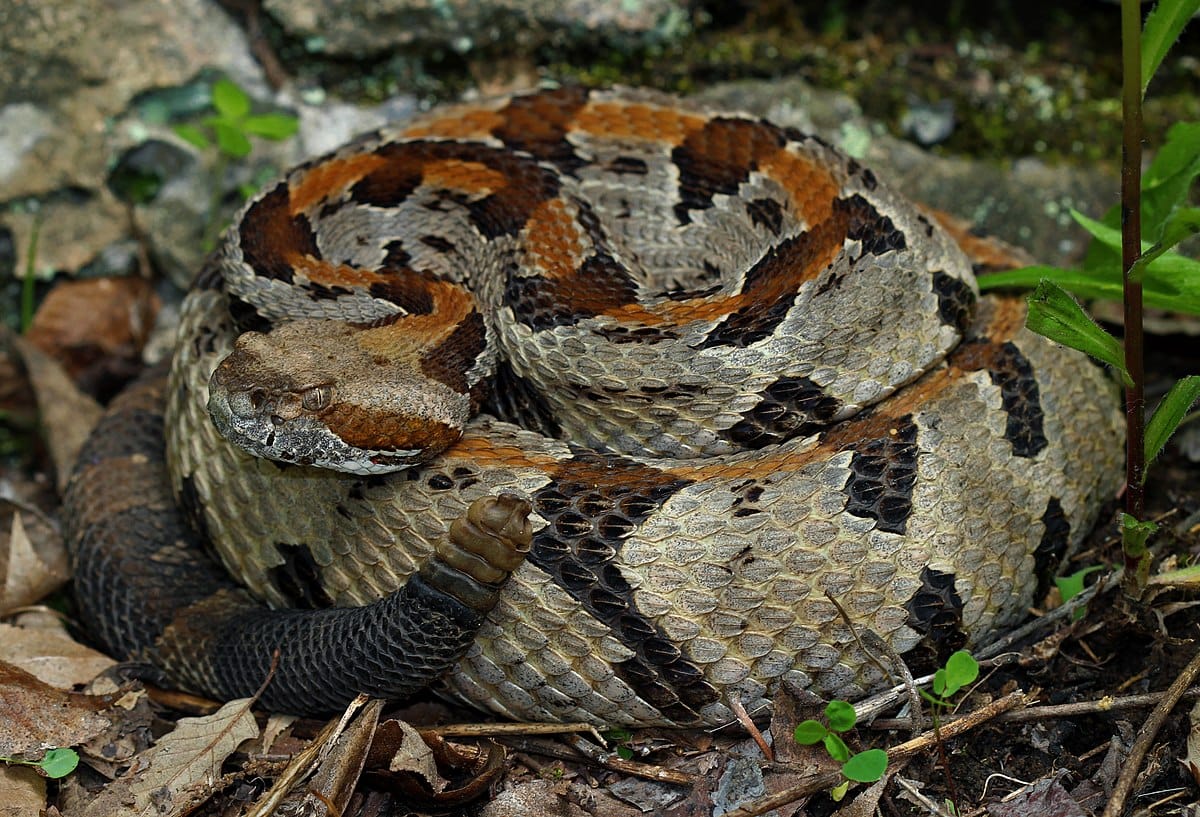
The Timber Rattlesnake is a powerful yet reclusive species native to the forests of eastern North America. It’s known for its calm demeanor, striking coloration, and distinctive rattle that warns intruders before a defensive strike.
Identification
Timber Rattlesnakes are large, thick-bodied snakes averaging 1–1.5 meters (3–5 ft) in length. Their body displays dark crossbands on a background that ranges from yellowish-brown to gray. The tail ends in a black rattle, and the head is triangular with heat-sensing pits on either side.
Venom and Behavior
Although the Timber Rattlesnake’s venom is highly potent, it rarely bites humans, preferring to rely on its rattle as a warning. The venom contains both hemotoxins and neurotoxins, capable of causing serious tissue damage and systemic effects if untreated. These snakes are patient ambush predators, feeding mainly on rodents and small birds.
Habitat and Range
They inhabit deciduous forests, rocky hillsides, and ridges throughout the eastern United States. During the colder months, Timber Rattlesnakes hibernate in communal dens, often returning to the same location year after year.
Fun Fact
Benjamin Franklin once proposed the Timber Rattlesnake as a symbol of American bravery, admiring its warning nature and fierce defense when provoked.
27. Horned Viper (Cerastes cerastes)
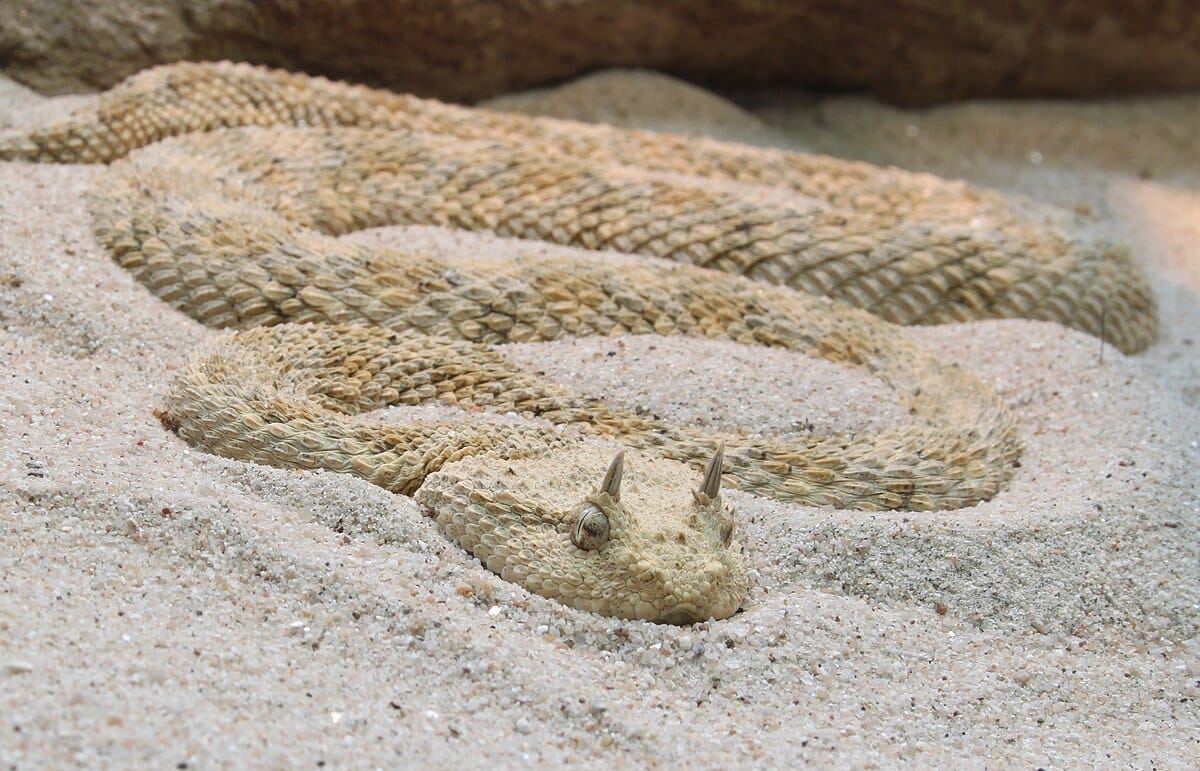
The Horned Viper, also known as the Desert Horned Viper, is one of the most distinctive snakes of North Africa and the Middle East. Named for the prominent horn-like scales above its eyes, it’s a true master of desert survival.
Identification
Horned Vipers are medium-sized snakes, typically 40–60 cm (1.5–2 ft) long. Their body color matches desert sands—ranging from pale yellow to reddish-brown—with darker patches forming irregular bands. The “horns” above their eyes can be raised or flattened depending on mood or habitat, adding to their menacing look.
Venom and Behavior
Its venom is cytotoxic, causing pain and swelling but rarely fatal with treatment. The Horned Viper uses a unique sideways “sidewinding” motion to move efficiently across loose sand while minimizing heat exposure. Despite its fearsome appearance, it is generally shy and relies on camouflage to avoid threats.
Habitat and Range
This species thrives in sandy deserts across North Africa, the Arabian Peninsula, and parts of Iran. It spends most of its time buried beneath the sand with only its eyes and horns exposed, ambushing unsuspecting lizards or rodents.
Fun Fact
When threatened, it produces a loud rasping sound by rubbing its body scales together—a behavior similar to that of the Saw-Scaled Viper.
28. Brown Tree Snake (Boiga irregularis)
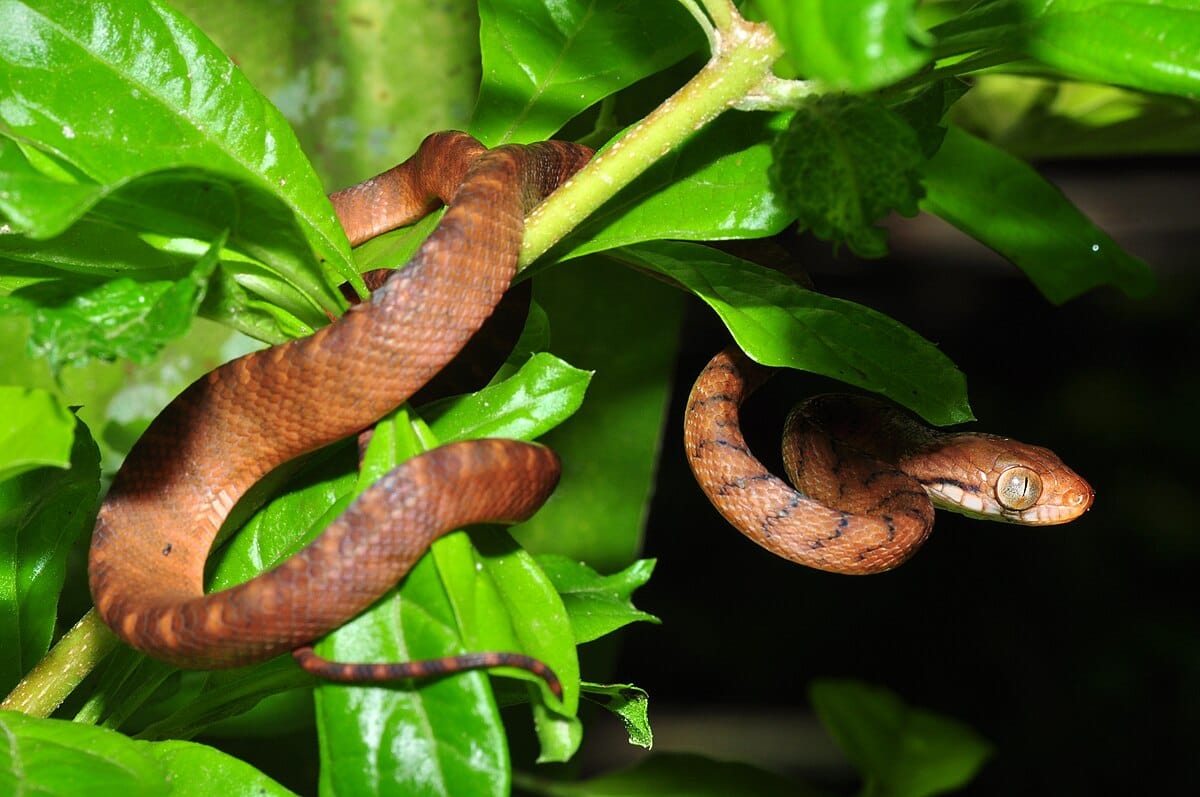
The Brown Tree Snake is a mildly venomous species native to Australia and Papua New Guinea but infamous as an invasive predator on Guam. It’s responsible for massive ecological damage to the island’s bird populations.
Identification
This slender snake can reach up to 2 meters (6.5 ft) in length. Its body is brown with irregular darker crossbands and a pale underside. It has large eyes with vertical pupils—well adapted for its nocturnal lifestyle. The head is long and narrow, distinct from the neck.
Venom and Behavior
The Brown Tree Snake is rear-fanged, meaning its venom delivery is less efficient than front-fanged species. Its venom is mildly neurotoxic and primarily used to subdue small prey. While not considered dangerous to adults, it can cause swelling and pain in small children or pets.
Habitat and Range
Originally from Australia, Papua New Guinea, and Indonesia, this species became invasive on Guam after World War II, where it decimated native bird species. It thrives in forests, urban areas, and even inside buildings, hunting birds, lizards, and small mammals.
Fun Fact
On Guam, Brown Tree Snakes have caused frequent power outages by climbing electrical lines and equipment—earning them a unique reputation as both predator and pest!
29. Blue Krait (Bungarus caeruleus)
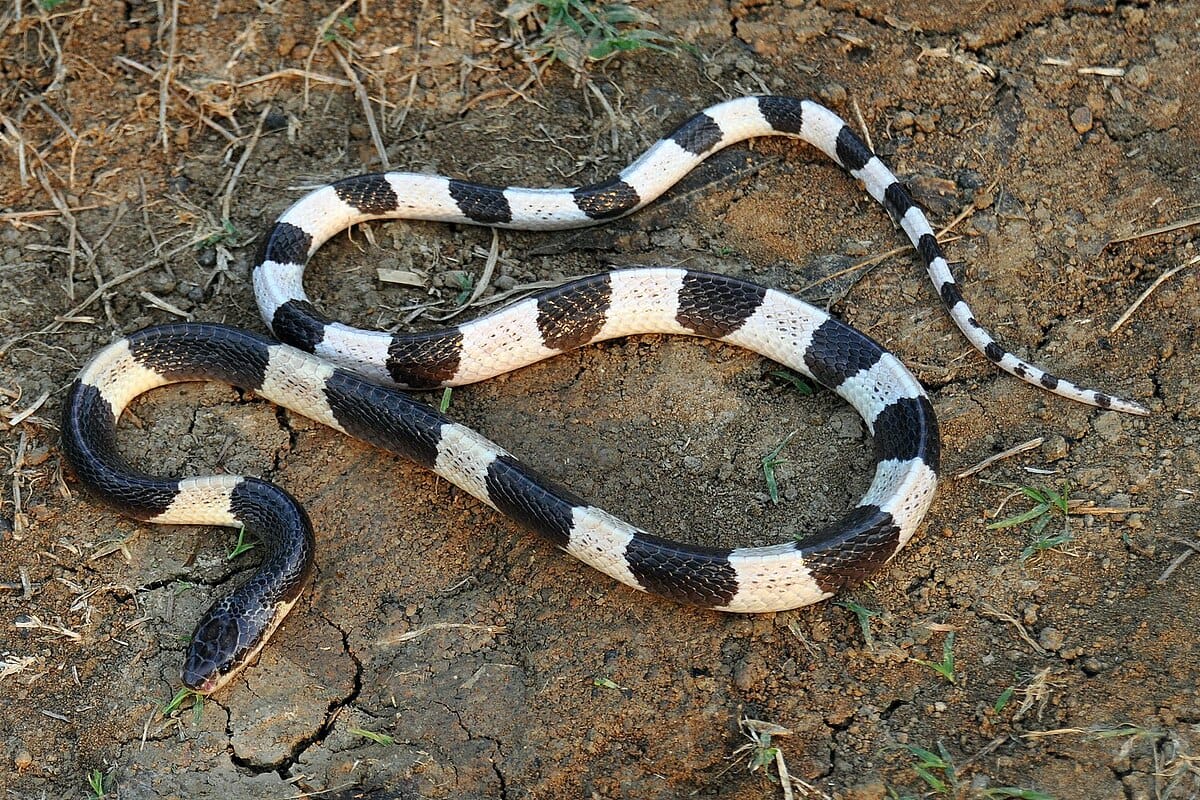
The Blue Krait, also known as the Common Krait, completes our list as one of the most dangerous snakes in Asia. This species combines beauty with lethality—its bite has one of the highest fatality rates of any land snake.
Identification
Blue Kraits are slender snakes, typically around 1–1.2 meters (3–4 ft) long, with alternating black and bluish-white bands along the body. The head is slightly flattened with a glossy finish, and the belly is pale. Their smooth scales give them a shiny, elegant appearance.
Venom and Behavior
The venom of the Blue Krait is extremely neurotoxic, capable of causing complete paralysis. Victims may initially feel little pain, but symptoms progress rapidly—making it one of the most insidious bites in the snake world. These snakes are nocturnal and secretive, often entering human settlements in search of prey like rodents and other snakes.
Habitat and Range
Found across India, Bangladesh, Nepal, and Southeast Asia, Blue Kraits inhabit forests, farmlands, and suburban areas. They prefer humid environments near rivers and rice fields.
Fun Fact
In many rural parts of Asia, the Blue Krait is known as the “silent killer” due to its habit of biting sleeping victims who rarely wake up in time to seek help.
FAQ — Venomous Snakes & Common Questions
1. What is the top 10 most venomous snakes?
Lists vary depending on how “venomous” is measured (LD₅₀, venom yield, human effects), but a commonly cited top-ten (in no strict order) includes: Inland Taipan, Coastal Taipan, Black Mamba, King Cobra, Many-banded Krait, Taipan species, Eastern Brown Snake, Blue Krait (Common Krait), Fer-de-Lance (Bothrops), and some highly toxic coral snakes. Keep in mind “most venomous” doesn’t always mean “most deadly to people” — risk depends on behavior, range, and access to medical care.
2. What are the 4 types of venom?
Venoms are commonly grouped by their dominant effects: neurotoxic (affects nerves and breathing), hemotoxic (disrupts blood and clotting), cytotoxic (damages local tissue and cells), and myotoxic (damages muscle). Many snake venoms are mixtures and can have two or more of these effects.
3. Are there venomous snakes in Vietnam?
Yes. Vietnam hosts many venomous species, including cobras (several Naja species), kraits, pit vipers (Trimeresurus and related groups), and sea snakes in coastal waters. Venomous snakes are part of the country’s natural fauna, especially in rural, forested, and rice-field areas.
4. How many types of snake venom are there in the world?
There’s no single fixed number — venom chemistry is extremely diverse. Scientists usually categorize venoms by their main biological effects (neurotoxic, hemotoxic, cytotoxic, myotoxic) and by the many distinct protein families they contain. New variations continue to be discovered as research progresses.
5. Which is the fastest killing snake in the world?
“Fastest” depends on dose, bite location, and medical care. Neurotoxic snakes (certain kraits, black mambas, and taipans) can cause respiratory failure rapidly — sometimes within an hour without treatment. The Inland Taipan has extremely potent venom by lab measures, and some kraits or mambas produce very rapid clinical collapse; but exact timing varies case by case.
6. What happens if bitten by a taipan?
Taipan bites inject potent neurotoxins and coagulants. Early signs can include pain, nausea, blurred vision, drooping eyelids, weakness, and difficulty breathing; bleeding problems may follow. Immediate medical care and species-appropriate antivenom are crucial — with treatment, survival chances rise dramatically.
7. What is the deadliest type of venom?
“Deadliest” depends on context. Neurotoxic venoms (which can cause rapid respiratory paralysis) and potent mixtures like those of some taipans and kraits are often considered the most immediately dangerous to humans. But highly hemotoxic venoms (certain vipers) cause severe local damage and systemic problems that can also be fatal.
8. What are the five venoms of death?
This phrase is not a strict scientific term, but a useful way to remember major harmful venom effects: neurotoxic, hemotoxic, cytotoxic, myotoxic — and you can add cardiotoxic (direct heart effects) or consider “mixed” venoms as the fifth category. Different authors phrase this differently, but the idea is the main functional damage types venoms cause.
9. Which animal is immune to snake venom?
Some species show strong resistance or near-immunity: mongooses, honey badgers, opossums, certain birds (like secretarybirds), and some snakes (e.g., kingsnakes that eat other snakes). “Immune” is relative — many of these animals tolerate venom better than most mammals, but resistance varies by snake species and dose.
10. What snake killed soldiers in Vietnam?
There isn’t one single species noted as “the snake that killed soldiers.” During the Vietnam War region, troops encountered cobras, kraits, and various pit vipers; kraits and vipers especially are historically implicated in many military and rural bite incidents. In short: multiple venomous species, not a single culprit.
11. What is king cobra in Vietnamese?
King cobra in Vietnamese is commonly called “rắn hổ mang chúa” or simply “hổ mang chúa”. (“Rắn hổ mang” = cobra; “chúa” implies the royal/king.)
12. What is the most snake-infested country?
There’s no official “most snake-infested” ranking. Countries with large, varied habitats and tropical climates — such as Australia, India, Brazil, and Indonesia — have very high snake diversity. “Infestation” depends on human population density, habitat overlap, and species behavior, not just raw species counts.
13. Which snake has killed the most humans?
Global epidemiology points to a few species causing the highest human mortality because of range and frequent human contact: saw-scaled vipers and Russell’s vipers (South Asia), certain cobras, and some Bothrops (fer-de-lance) in the Americas. In many regions, saw-scaled vipers are consistently linked to high bite and death rates.
14. Can you outrun an anaconda?
On land, humans are faster than anacondas — so yes, you can usually outrun one. In water, however, anacondas are much stronger and better swimmers; escape is far harder. Avoid water where large constrictors are present and never provoke or approach them.
15. Can you build immunity to snake venom?
Partial immunity (antibodies) can develop after repeated, controlled exposure, which some handlers historically attempted (mithridatism). However, this is dangerous, unpredictable, and not a reliable or safe strategy. Modern prophylaxis is antivenom produced by immunizing animals and purifying antibodies — not self-immunization.
16. Do snakes recognize humans?
Snakes don’t recognize humans like pets recognize owners, but they can learn to associate specific people or places with nonthreatening or threatening experiences via scent and behavior cues. They respond primarily to smell, thermal cues, and movement rather than to an abstract idea of “human.”
17. What snake is most likely to eat a human?
Documented cases are extremely rare. Very large constrictors — reticulated pythons and green anacondas — have been recorded preying on humans in rare circumstances, usually involving small children or adults in remote locations. Such events are exceptional, not normal behavior.
18. Where do King Cobras live?
King Cobras are found across South and Southeast Asia: India, Bangladesh, Myanmar, Thailand, Malaysia, Indonesia (some islands), southern China, and parts of the Philippines. They prefer forests, bamboo thickets, and riparian (river) habitats and are often near water.
19. Which snake has the highest IQ?
There’s no accepted “IQ” for snakes. Some species show greater learning and problem-solving in experiments (e.g., active foragers like corn snakes or kingsnakes), but intelligence across snakes is measured in different ways. It’s more accurate to say certain species display higher behavioral flexibility rather than assign an IQ.
20. What is king cobra afraid of?
King Cobras avoid large mammals and human activity. They will retreat if possible and show defensive displays when cornered. Predators or threats can include large mammals, crocodiles, and people; however, their size and venom make them less vulnerable than many other snakes.
21. What should I do if I see a cobra?
Stay calm and keep your distance. Back away slowly without sudden movements, give the snake a clear escape route, and don’t try to handle or provoke it. If it’s in a populated area, contact local wildlife control or authorities who can safely relocate it.
22. Which snake venom kills the slowest?
Venoms that are primarily hemotoxic or cytotoxic (many vipers) often produce slower, progressing symptoms — swelling, tissue necrosis, and systemic bleeding over hours to days — compared with fast-acting neurotoxins which can cause rapid respiratory failure. “Slowest” can vary widely with dose and medical care.
23. Are snakes deaf?
Snakes lack external ears but are not deaf. They detect airborne sounds poorly but sense ground vibrations very well through their jaw bones and inner ear, and they can perceive low-frequency sounds. They rely on vibration, smell (tongue/forked), and heat sensing more than hearing.
24. What is the most poisonous animal in the world?
If you mean most venomous to humans, contenders include the box jellyfish (Chironex fleckeri), some cone snails, and certain tiny marine animals. For snakes specifically, the Inland Taipan is often listed as the most venomous by laboratory LD₅₀ tests. “Poisonous” and “venomous” are different terms: poisonous means harmful when eaten, while venomous animals inject toxins.
25. What is the antidote for snake bite?
The primary antidote is species- or region-specific antivenom (antibody therapy). First aid while getting to a hospital includes keeping the victim calm, immobilizing the bitten limb at heart level, and rapid transport to medical care. Avoid tourniquets, cutting the wound, or trying to suck out venom — these actions can cause harm.
26. Are horses immune to snake venom?
No — horses are not immune. They can be very susceptible to some snake venoms and may suffer severe illness or death. Some horses have been treated successfully with antivenom, but prevention (keeping snakes away from stables and feed) is the best strategy.
27. Are monkeys immune to snake venom?
Most monkeys are not immune. Some primates may tolerate certain venoms better than other mammals, but generally they remain vulnerable to dangerous snakebites. Resistance varies by species and venom type.
28. What snake is used in Bullet Train?
In the movie Bullet Train, the plot references boomslang venom, but many sources and prop experts note the on-screen snake appears to be modeled after or depicted as an Asian “beauty” rat snake (a non-venomous species) rather than a true boomslang. In short: the film uses a fictionalized/prop representation rather than a strictly accurate real-world species.
29. Which snake kills a human the fastest?
Rapid fatalities are most often caused by powerful neurotoxic venoms (some kraits, taipans, and mambas) because they can shut down breathing quickly. Exact timing depends on the amount injected, bite location, and how fast antivenom is given; prompt medical care changes outcomes dramatically.
30. What snake bite makes you bleed from your eyes?
Severe coagulopathy from some viper bites (for example Russell’s viper or other vipers causing clotting failure) can lead to abnormal bleeding from many sites, potentially including the eyes. Any unusual bleeding after a bite is a medical emergency — seek immediate care.
31. Can snake venom blind you?
Certain venoms can damage ocular tissues if venom is spat into the eyes (spitting cobras) or if systemic effects include bleeding or swelling that affects vision. Spitting cobra venom can cause intense pain and possible eye damage unless flushed and treated promptly.
32. How can you tell if a snake bite is poisonous?
Look for puncture marks, swelling, pain, redness, and progressive symptoms (nausea, drooping eyelids, muscle weakness, breathing trouble, or bleeding). However, some venomous bites are initially painless and symptoms can be delayed — treat any suspected venomous bite seriously and get medical help quickly.
33. Which snake bite causes blood clots?
Some snake venoms cause abnormal clotting (coagulopathy) — notably Russell’s viper, some Bothrops species, and other vipers — which can lead to both excessive clotting and later bleeding when clotting factors are exhausted. Venom effects on clotting are complex and medically serious.
34. Can you survive an Inland Taipan bite?
Yes — survival is possible with immediate medical care and the correct antivenom. The Inland Taipan’s venom is extremely potent, but it’s also reclusive and human bites are rare; where antivenom and rapid treatment exist, outcomes are much better than in the past.
35. What snake has the quickest strike?
Several ambush predators are famously fast: Death Adders are among the fastest striking snakes (strikes measured in fractions of a second). Many vipers and some elapids also exhibit extremely rapid strike speeds — evolution favors speed for ambush hunters.
36. What snake did Rip use in Yellowstone?
In the TV show Yellowstone, the snake used in the cooler scene is depicted as a rattlesnake; production notes and episode commentary commonly identify it as a Western/Prairie-type rattlesnake used for dramatic effect. Show props often emphasize species that fit the local fauna (rattlesnakes in the American West).
37. What animal is immune to snakes?
Some animals show high resistance: mongooses, honey badgers, opossums, certain birds of prey (e.g., secretarybird), and some snakes (e.g., kingsnakes). These animals have evolved physiological or behavioral defenses that let them survive bites that would be fatal to other species.
38. Who is faster, mongoose or cobra?
Mongoose species are generally faster and far more agile in close combat than cobras. Their speed, reflexes, and thick fur/skin, plus some biochemical resistance to venom, help mongooses win many encounters with cobras in nature.
39. Which person is immune to snake venom?
No person is naturally immune to all snake venoms. Some handlers historically developed partial tolerance through repeated controlled exposures, but that is dangerous and unreliable. The safest protection is antivenom and good safety practices, not self-immunization.
40. What to do if an anaconda wraps around you?
Large constrictors kill by constriction, so immediate action is to protect your airway and try to prevent the snake from pulling you under water. If possible, use a tool or get help to pry the coils starting from the tail end (coils applied last are easier to remove). Avoid lunging or twisting; call for help. In a survival situation, targeting the snake’s head to force it to release is sometimes recommended, but these are high-risk maneuvers and should be last resorts.
41. How tight can an anaconda squeeze you?
Anacondas are powerful: their muscles can generate enormous pressure — enough to immobilize and suffocate large prey. Exact pressures vary by size and species, but large green anacondas can subdue sizeable mammals. Constriction compresses chest and stops breathing, which is how they kill.
42. Can you outrun a gorilla?
Yes. Gorillas are very strong but not built for long, fast chases. Humans can usually outrun a gorilla in a sprint and certainly over distance. Avoid provoking gorillas — they’re strong and dangerous in close encounters despite lower top speeds.
43. Which is the only country with no snakes?
Several places have no native snakes, most famously Ireland (legend aside) and also Iceland, Greenland, and New Zealand (which has virtually no native land snakes). Ireland is the classic answer in popular culture.
44. What island has the most snakes in the world?
“Most snakes” by raw species richness tends to be islands in the Indo-Malay region (Indonesia and New Guinea) which have extremely high reptile diversity. If you mean the most problematic invasive snake population, Guam is famous for having been devastated by invasive brown tree snakes.
45. What country eats the most snakes?
Snake consumption is traditional in parts of East and Southeast Asia (China, Vietnam, Thailand, parts of Laos and Cambodia). Exact per-country consumption statistics are hard to verify, but cultural cuisine and medicinal uses make these regions the most notable.
46. Can snakes run out of venom?
Yes. Venom is a metabolically expensive resource. Snakes can deliver a “dry bite” (no venom) or deplete their venom and will need time to rebuild venom stores after heavy use. Venom regeneration takes hours to days depending on the species and individual condition.
47. What are venom’s weaknesses?
Venoms are biological proteins and peptides — they’re vulnerable to early medical treatment: timely antivenom, supportive care (respiratory support, fluids, blood products), and wound management. In the environment, heat or enzymes can degrade venom, but clinically the “weakness” is that many venoms are neutralized by the correct antivenom when given promptly.
48. What is the most painful snake bite?
Pain is subjective, but bites from viperids (e.g., some Bothrops, puff adders, Russell’s viper) are often described as intensely painful due to local tissue destruction. Spitting cobras can cause severe burning pain if venom contacts the eyes.
49. What’s the difference between poisonous and venomous?
Simple rule: Venomous animals inject toxins (bite or sting). Poisonous animals are harmful when touched or eaten. So a venomous snake injects venom; a poisonous frog is harmful to eat or touch.
50. What’s the most painful venom in the world?
Pain from venom varies by type and victim. Some viper bites produce extreme local pain and tissue damage; a few marine venoms (e.g., stonefish) cause excruciating pain. There’s no single universal scale, but stings from certain fish and jellyfish are often ranked among the most painful recorded.
Conclusion
Venomous snakes are among nature’s most fascinating yet misunderstood creatures. From the deserts of Australia to the forests of Asia and the plains of Africa, each species has evolved its own unique adaptations to survive and hunt. While their venom can be deadly, these reptiles play a vital ecological role in controlling pest populations and maintaining balance in their ecosystems. Respecting their space and understanding their behavior ensures safe coexistence between humans and these remarkable predators.
Read more:
